Berthold Konrad
Hermann Albert Speer, 1905-1981
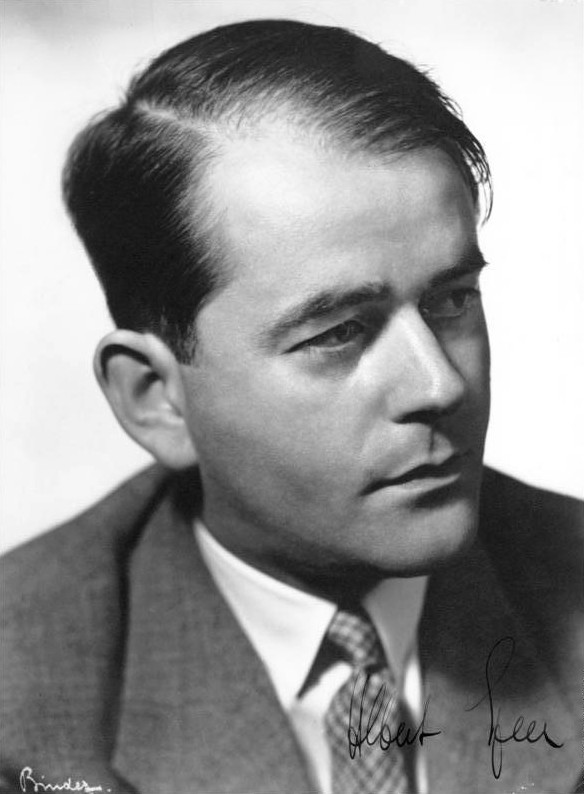
Berthold Konrad
Hermann Albert Speer, 1905-1981

1942年 以降、ヒトラーの12年にわた る政権中、ドイツ軍需・戦時生産相として帝国下の戦争関連の科学技術を統括。何百万人という強制労働者を収容所送りにした。ニュルンベルク裁判で有罪判 決を受け、シュパンダウの刑務所で懲役20年の刑に服した。出所後、複数の回顧録を執筆したが、ホロコーストについてはまったく知らなかったと主張。
1905 マンハイム(Mannheim) に生まれる
1923 カールスルーエ工科大学に入学
1924 ミュンヘン工科大学に転学
1925 ベルリン工科大学に転学。ハイ ンリヒ・テセノウ(Heinrich Tessenow)の指導を受ける。
1927 ハインリヒ・テセノウ(Heinrich Tessenow)の助手
1928 マルガレーテ・ヴェーバーと結 婚
1930 12月ビアホール党集会に出席
1931 国家社会主義ドイツ労働者党 (ナチ党)に入党。国家社会主義自動 車軍団(Nationalsozialistisches Kraftfahrkorps, NSKK) に入団。
1932 マンハイムに移り、建築家とし て自立。7月ナチ党ベルリン大管区組織部長カール・ハンケが、シュペーアをベルリン大管区指導者ヨーゼ フ・ゲッベルスに紹介。
1933 1月30日ヒトラー首相に就 任。その後パウル・トロースト(Paul Troost) が行なっていた総統官邸(初代)の改修を手がける。
1934 ニュルンベルクの党大会会場(Parteitagsgelände) の設計。その後、「廃墟価値の理論(Ruinenwerttheorie) [Ruin value]」を考案し た。
1937 パリ万博ドイツ・パビリオン。 同年、ベルリン建設総監 (Generalbauinspektor für die Hauptstadt Berlin) 。
1942 2月7日軍需相(兵器・弾薬大 臣[Reichsministerium für Bewaffnung und Munition])のフリッツ・ トート[Fritz Todt, 1891-1942]が飛行機事故死したために、後任に(1942-1943年兵器・弾薬大臣、1943-1945年軍需・軍事生産大臣)
兵器開発のデモンストレーション (1943年10月)
1944 1月ごろ、ヒトラーに辞任を申 し出る(本人の弁)。5月職場復帰。10月連合軍の西部侵攻がはじまる。
1945 ヒトラーによるネロ命令[Nerobefehl, Befehl betreffend Zerstörungsmaßnahmen im Reichsgebiet, Nero Decree]4月23日ヒ トラーと会談。5月23日逮捕(→「ペーパークリップ作戦」)
★ウィキペディア(英語)のアルベルト・
シュペーア(Berthold Konrad
Hermann Albert Speer)
| Berthold Konrad
Hermann Albert Speer (/ʃpɛər/; German: [ˈʃpeːɐ̯] ⓘ; 19 March 1905 –
1
September 1981) was a German architect who served as the Minister of
Armaments and War Production in Nazi Germany during most of World War
II. A close ally of Adolf Hitler, he was convicted at the Nuremberg
trials and sentenced to 20 years in prison. An architect by training, Speer joined the Nazi Party in 1931. His architectural skills made him increasingly prominent within the Party, and he became a member of Hitler's inner circle. Hitler commissioned him to design and construct structures including the Reich Chancellery and the Nazi party rally grounds in Nuremberg. In 1937, Hitler appointed Speer as General Building Inspector for Berlin. In this capacity he was responsible for the Central Department for Resettlement that evicted Jewish tenants from their homes in Berlin. In February 1942, Speer was appointed as Reich Minister of Armaments and War Production. Using misleading statistics, he promoted himself as having performed an armaments miracle that was widely credited with keeping Germany in the war.[1] In 1944, Speer established a task force to increase production of fighter aircraft. It became instrumental in exploiting slave labor for the benefit of the German war effort. After the war, Albert Speer was among the 24 "major war criminals" charged with the crimes of the Nazi regime before the International Military Tribunal. He was found guilty of war crimes and crimes against humanity, principally for the use of slave labor, narrowly avoiding a death sentence. Having served his full term, Speer was released in 1966. He used his writings from the time of imprisonment as the basis for two autobiographical books, Inside the Third Reich and Spandau: The Secret Diaries. Speer's books were a success; the public was fascinated by an inside view of the Third Reich. He died of a stroke in 1981. Through his autobiographies and interviews, Speer carefully constructed an image of himself as a man who deeply regretted having failed to discover the crimes of the Third Reich. He continued to deny explicit knowledge of, and responsibility for, the Holocaust. This image dominated his historiography in the decades following the war, giving rise to the "Speer Myth": the perception of him as an apolitical technocrat responsible for revolutionizing the German war machine. The myth began to fall apart in the 1980s, when the armaments miracle was attributed to Nazi propaganda. Adam Tooze wrote in The Wages of Destruction that the idea that Speer was an apolitical technocrat was "absurd". Martin Kitchen, writing in Speer: Hitler's Architect, stated that much of the increase in Germany's arms production was actually due to systems instituted by Speer's predecessor (Fritz Todt) and that Speer was intimately aware of and involved in the "Final Solution", evidence of which has been conclusively shown in the decades following the Nuremberg Trials. |
ベルトルト・コンラート・ヘルマン・アルベルト・シュペーア
(Berthold Konrad Hermann Albert Speer,/ʃɛər/ ; German:[ˈʃ]ⓘ 1905年3月19日
-
1981年9月1日)はドイツの建築家で、第二次世界大戦の大半の間、ナチス・ドイツの軍需・戦争生産大臣を務めた。アドルフ・ヒトラーの側近であり、
ニュルンベルク裁判で有罪判決を受け、20年の禁固刑を言い渡された。 建築家出身のシュペーアは1931年にナチ党に入党した。その建築技術によって党内で次第に頭角を現し、ヒトラーの側近となった。ヒトラーはシュペーアに 帝国首相官邸やニュルンベルクの ナチ党集会場などの設計・建設を依頼した。1937年、ヒトラーはシュペーアをベルリン建築総監督に任命した。この職責で彼は、ベルリンに住むユダヤ人借 家人を立ち退かせる再定住中央局の責任者となった。1942年2月、シュペーアは帝国軍需・戦争生産大臣に任命された。1944年、シュペーアは戦闘機増 産のためのタスクフォースを設置した。このタスクフォースは、ドイツの戦争努力のために奴隷労働者を搾取するのに役立った。 戦後、アルベルト・シュペアは国際軍事法廷において、ナチス政権の罪を問われた24人の「主要戦争犯罪人」のひとりとなった。彼は戦争犯罪と 人道に対する罪、主に奴隷労働の使用で有罪となり、辛うじて死刑判決は免れた。刑期を全うしたシュペアは1966年に釈放された。シュペーアは投獄中に書 いた2冊の自伝的著書『Inside the Third Reich』と『Spandau: The Secret Diaries』である。シュペーアの著書は成功を収め、第三帝国の内幕に大衆は魅了された。彼は1981年に脳卒中で亡くなった。 シュペーアは自伝やインタビューを通じて、第三帝国の犯罪を発見できなかったことを深く後悔している男というイメージを注意深く作り上げた。彼は、ホロ コーストについての明確な知識と責任を否定し続けた。このイメージは戦後数十年間、彼の歴史学を支配し、「シュペーア神話」を生み出した。この神話は 1980年代に崩れ始め、軍備の奇跡はナチスのプロパガンダによるものとされた。アダム・トゥーゼは『破壊の賃金』の中で、シュペーアが非政治的な技術者 であったという考えは「馬鹿げている」と書いている。マーティン・キッチンは『シュペーア』にこう書いている: ヒトラーの建築家』の中でマーティン・キッチンは、ドイツの兵器生産の増加の多くは、実際にはシュペーアの前任者(フリッツ・トッド)が制定したシステム によるものであり、シュペーアは「最終的解決」を深く認識し、それに関与していたと述べている。 |
| Early years and personal life Speer was born in Mannheim, into an upper-middle-class family. He was the second of three sons of Luise Máthilde Wilhelmine (Hommel) and Albert Friedrich Speer.[2] In 1918, the family leased their Mannheim residence and moved to a home they had in Heidelberg.[3] Henry T. King, deputy prosecutor at the Nuremberg trials who later wrote a book about Speer said, "Love and warmth were lacking in the household of Speer's youth."[4] His brothers, Ernst and Hermann, bullied him throughout his childhood.[5] Speer was active in sports, taking up skiing and mountaineering.[6] He followed in the footsteps of his father and grandfather and studied architecture.[7] Speer began his architectural studies at the University of Karlsruhe instead of a more highly acclaimed institution because the hyperinflation crisis of 1923 limited his parents' income.[8] In 1924, when the crisis had abated, he transferred to the "much more reputable" Technical University of Munich.[9] In 1925, he transferred again, this time to the Technical University of Berlin where he studied under Heinrich Tessenow, whom Speer greatly admired.[10] After passing his exams in 1927, Speer became Tessenow's assistant, a high honor for a man of 22.[11] As such, Speer taught some of his classes while continuing his own postgraduate studies.[12] In Munich Speer began a close friendship, ultimately spanning over 50 years, with Rudolf Wolters, who also studied under Tessenow.[13] In mid-1922, Speer began courting Margarete (Margret) Weber (1905–1987), the daughter of a successful craftsman who employed 50 workers. The relationship was frowned upon by Speer's class-conscious mother, who felt the Webers were socially inferior. Despite this opposition, the two married in Berlin on 28 August 1928; seven years elapsed before Margarete was invited to stay at her in-laws' home.[14] The couple would have six children together, but Albert Speer grew increasingly distant from his family after 1933. He remained so even after his release from imprisonment in 1966, despite their efforts to forge closer bonds.[15] |
生い立ちと私生活[編集]。 シュペアはマンハイムで上流中産階級の家庭に生まれた。1918年、一家はマンハイムにあった住居を賃貸し、ハイデルベルクにあった家に引っ越した [3]。ニュルンベルク裁判の副検察官で、後にシュペーアについての本を書いたヘンリー・T・キングは、「シュペーアの少年時代の家庭には愛と温かさが欠 けていた」と述べている[4]。 「シュペアはスポーツに積極的で、スキーや登山を始めた[6]。父と祖父の跡を継ぎ、建築を学んだ[7]。 1923年のハイパーインフレ危機によって両親の収入が制限されたため、シュペーアはより評価の高い大学ではなく、カールスルーエ大学で建築の勉強を始め た[8]。1924年、危機が和らぐと、彼は「はるかに評判の高い」ミュンヘン工科大学に転校した[9]。1925年、彼は再びベルリン工科大学に転校 し、シュペーアが非常に尊敬していたハインリヒ・テッセノフに師事した。 [1927年に試験に合格したシュペーアはテッセノフの助手となり、22歳の若さにしては名誉なことであった[11]。ミュンヘンでは、同じくテッセノフ に師事していたルドルフ・ヴォルタースと、最終的には50年以上にわたる親密な友人関係を築いた[13]。 1922年半ば、シュペーアは、50人の労働者を雇う成功した職人の娘、マルガレーテ(マルグレット)・ヴェーバー(1905-1987)と求愛を始め た。シュペーアの階級意識の強い母親は、ウェーバー夫妻が社会的に劣っていると感じ、この交際を嫌った。この反対にもかかわらず、2人は1928年8月 28日にベルリンで結婚した。マルガレーテが義理の両親の家に招かれるまでに7年が経過した[14]。2人の間には6人の子供が生まれたが、アルベルト・ シュペアは1933年以降、家族から次第に距離を置くようになった。1966年に投獄から解放された後も、より親密な絆を築こうと努力したにもかかわら ず、その状態が続いた[15]。 |
| Party architect and government
functionary Joining the Nazis (1931–1934) 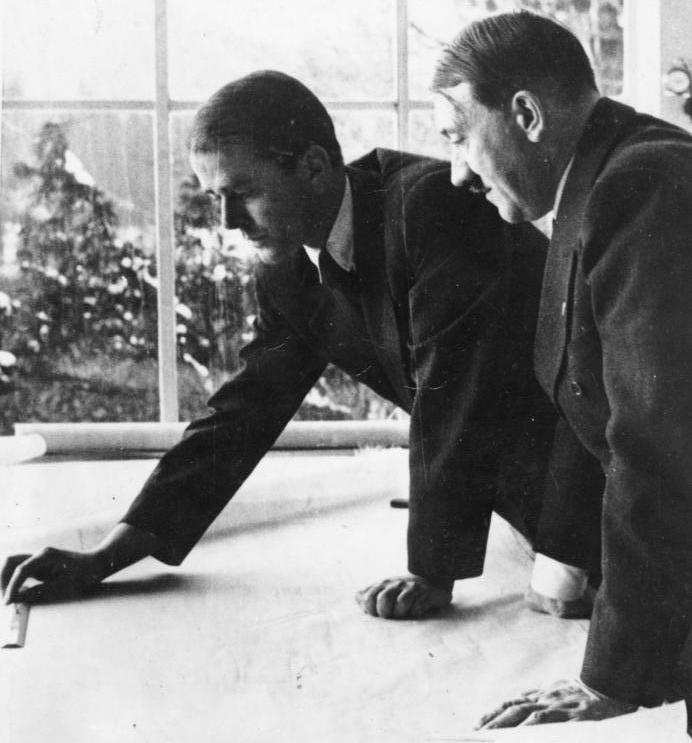 Speer shows Hitler a project at Obersalzberg. In January 1931, Speer applied for Nazi Party membership, and on 1 March 1931, he became member number 474,481.[16][b] The same year, with stipends shrinking amid the Depression, Speer surrendered his position as Tessenow's assistant and moved to Mannheim, hoping to make a living as an architect. After he failed to do so, his father gave him a part-time job as manager of his properties. In July 1932, the Speers visited Berlin to help out the Party before the Reichstag elections. While they were there his friend, Nazi Party official Karl Hanke recommended the young architect to Joseph Goebbels to help renovate the Party's Berlin headquarters. When the commission was completed, Speer returned to Mannheim and remained there as Hitler took office in January 1933.[18] The organizers of the 1933 Nuremberg Rally asked Speer to submit designs for the rally, bringing him into contact with Hitler for the first time. Neither the organizers nor Rudolf Hess were willing to decide whether to approve the plans, and Hess sent Speer to Hitler's Munich apartment to seek his approval.[19] This work won Speer his first national post, as Nazi Party "Commissioner for the Artistic and Technical Presentation of Party Rallies and Demonstrations".[20] Shortly after Hitler came into power, he began to make plans to rebuild the chancellery. At the end of 1933, he contracted Paul Troost to renovate the entire building. Hitler appointed Speer, whose work for Goebbels had impressed him, to manage the building site for Troost.[21] As Chancellor, Hitler had a residence in the building and came by every day to be briefed by Speer and the building supervisor on the progress of the renovations. After one of these briefings, Hitler invited Speer to lunch, to the architect's great excitement.[22] Speer quickly became part of Hitler's inner circle; he was expected to call on him in the morning for a walk or chat, to provide consultation on architectural matters, and to discuss Hitler's ideas. Most days he was invited to dinner.[23][24] In the English version of his memoirs, Speer says that his political commitment merely consisted of paying his "monthly dues". He assumed his German readers would not be so gullible and told them the Nazi Party offered a "new mission". He was more forthright in an interview with William Hamsher in which he said he joined the party in order to save "Germany from Communism".[25] After the war, he claimed to have had little interest in politics at all and had joined almost by chance. Like many of those in power in the Third Reich, he was not an ideologue, "nor was he anything more than an instinctive anti-Semite."[16] The historian Magnus Brechtken, discussing Speer, said he did not give anti-Jewish public speeches and that his anti-Semitism can best be understood through his actions—which were anti-Semitic.[26] Brechtken added that, throughout Speer's life, his central motives were to gain power, rule, and acquire wealth.[27] Nazi architect (1934–1937) Main article: Nazi architecture 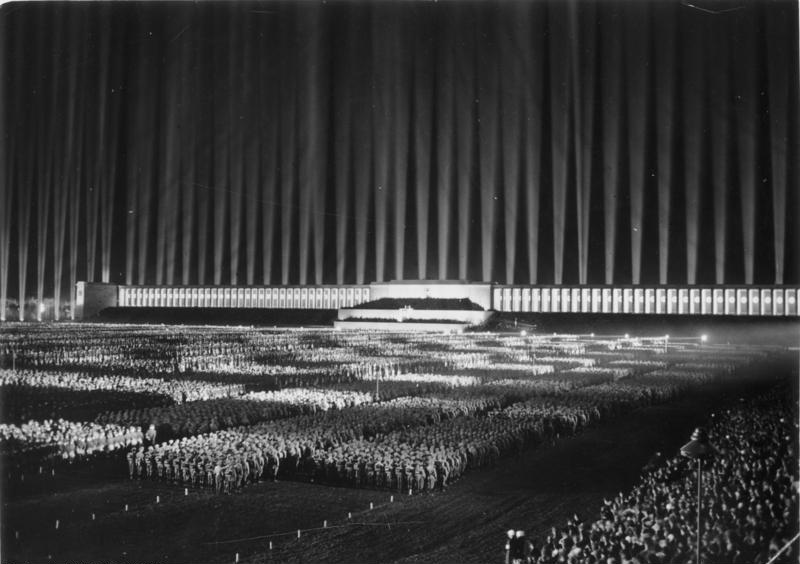 The Cathedral of Light above the Zeppelintribune When Troost died on 21 January 1934, Speer effectively replaced him as the Party's chief architect. Hitler appointed Speer as head of the Chief Office for Construction, which placed him nominally on Hess's staff.[28] One of Speer's first commissions after Troost's death was the Zeppelinfeld stadium in Nuremberg. It was used for Nazi propaganda rallies and can be seen in Leni Riefenstahl's propaganda film Triumph of the Will. The building was able to hold 340,000 people.[29] Speer insisted that as many events as possible be held at night, both to give greater prominence to his lighting effects and to hide the overweight Nazis.[30] Nuremberg was the site of many official Nazi buildings. Many more buildings were planned. If built, the German Stadium in Nuremberg would have accommodated 400,000 spectators.[29] Speer modified Werner March's design for the Olympic Stadium being built for the 1936 Summer Olympics. He added a stone exterior that pleased Hitler.[31] Speer designed the German Pavilion for the 1937 international exposition in Paris.[32] Berlin's General Building Inspector (1937–1942) 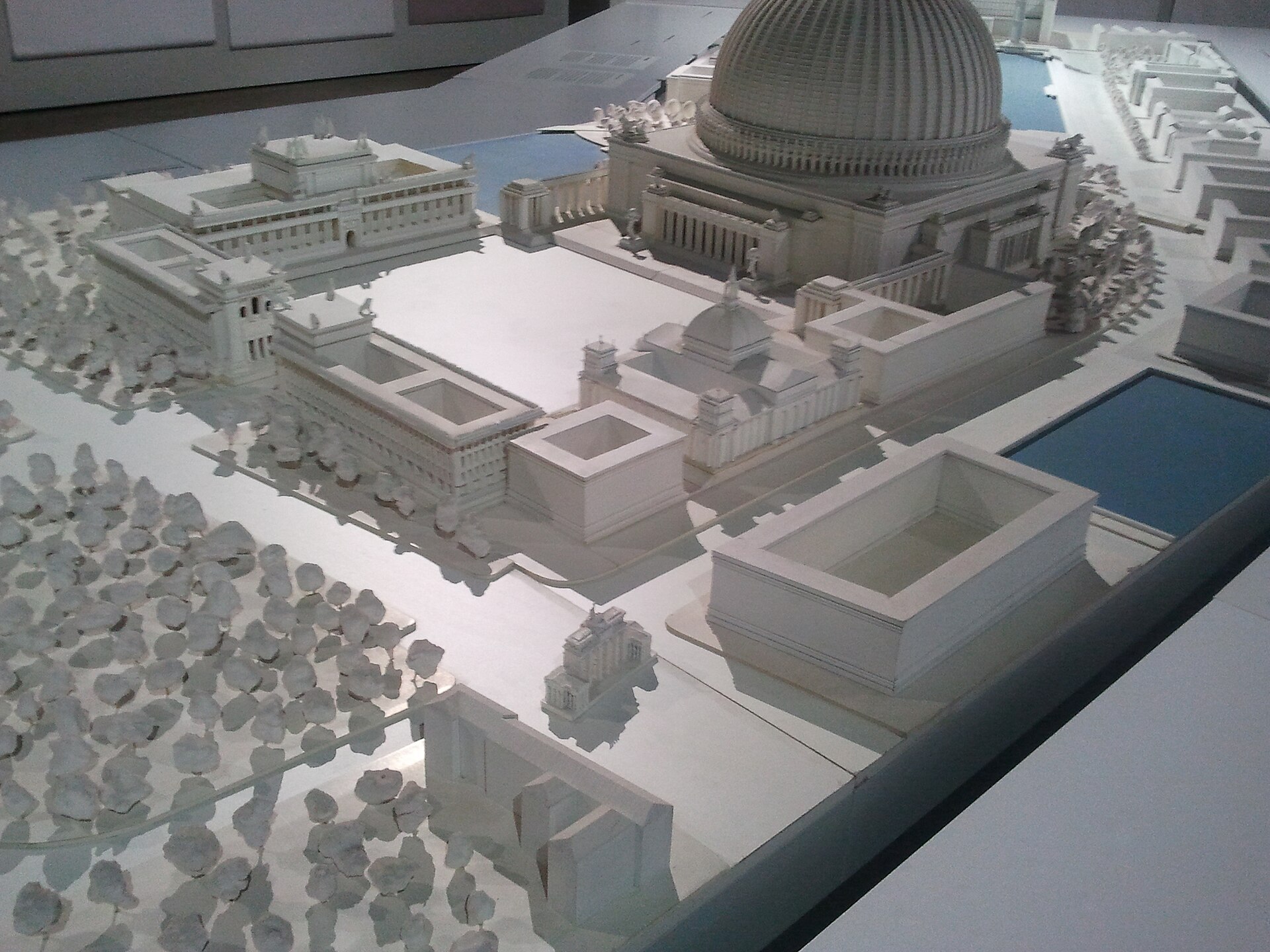 Model of the Große Halle (also called Ruhmeshalle or Volkshalle) with the Reichstag building and the Brandenburg Gate On 30 January 1937, Hitler appointed Speer as General Building Inspector for the Reich Capital. This carried with it the rank of State Secretary in the Reich government and gave him extraordinary powers over the Berlin city government.[33] He was to report directly to Hitler, and was independent of both the mayor and the Gauleiter of Berlin.[34] Hitler ordered Speer to develop plans to rebuild Berlin. These centered on a three-mile-long grand boulevard running from north to south, which Speer called the Prachtstrasse, or Street of Magnificence;[35] he also referred to it as the "North–South Axis".[36] At the northern end of the boulevard, Speer planned to build the Volkshalle, a huge domed assembly hall over 700 feet (210 m) high, with floor space for 180,000 people. At the southern end of the avenue, a great triumphal arch, almost 400 feet (120 m) high and able to fit the Arc de Triomphe inside its opening, was planned. The existing Berlin railroad termini were to be dismantled, and two large new stations built.[37] Speer hired Wolters as part of his design team, with special responsibility for the Prachtstrasse.[38] The outbreak of World War II in 1939 led to the postponement, and later the abandonment, of these plans,[39] which, after Nazi capitulation, Speer himself considered as “awful”.[40]  The Volkshalle's Great Dome can be seen at the top of this model of Hitler's plan for Berlin. Plans to build a new Reich chancellery had been underway since 1934. Land had been purchased by the end of 1934 and starting in March 1936 the first buildings were demolished to create space at Voßstraße.[41] Speer was involved virtually from the beginning. In the aftermath of the Night of the Long Knives, he had been commissioned to renovate the Borsig Palace on the corner of Voßstraße and Wilhelmstraße as headquarters of the Sturmabteilung (SA).[42] He completed the preliminary work for the new chancellery by May 1936. In June 1936 he charged a personal honorarium of 30,000 Reichsmark and estimated the chancellery would be completed within three to four years. Detailed plans were completed in July 1937 and the first shell of the new chancellery was complete on 1 January 1938. On 27 January 1938, Speer received plenipotentiary powers from Hitler to finish the new chancellery by 1 January 1939. For propaganda Hitler claimed during the topping-out ceremony on 2 August 1938, that he had ordered Speer to complete the new chancellery that year.[43] Shortages of labor meant the construction workers had to work in ten-to-twelve-hour shifts.[44] The SS built two concentration camps in 1938 and used the inmates to quarry stone for its construction. A brick factory was built near the Oranienburg concentration camp at Speer's behest; when someone commented on the poor conditions there, Speer stated, "The Yids got used to making bricks while in Egyptian captivity".[45] The chancellery was completed in early January 1939.[44] The building itself was hailed by Hitler as the "crowning glory of the greater German political empire".[44] 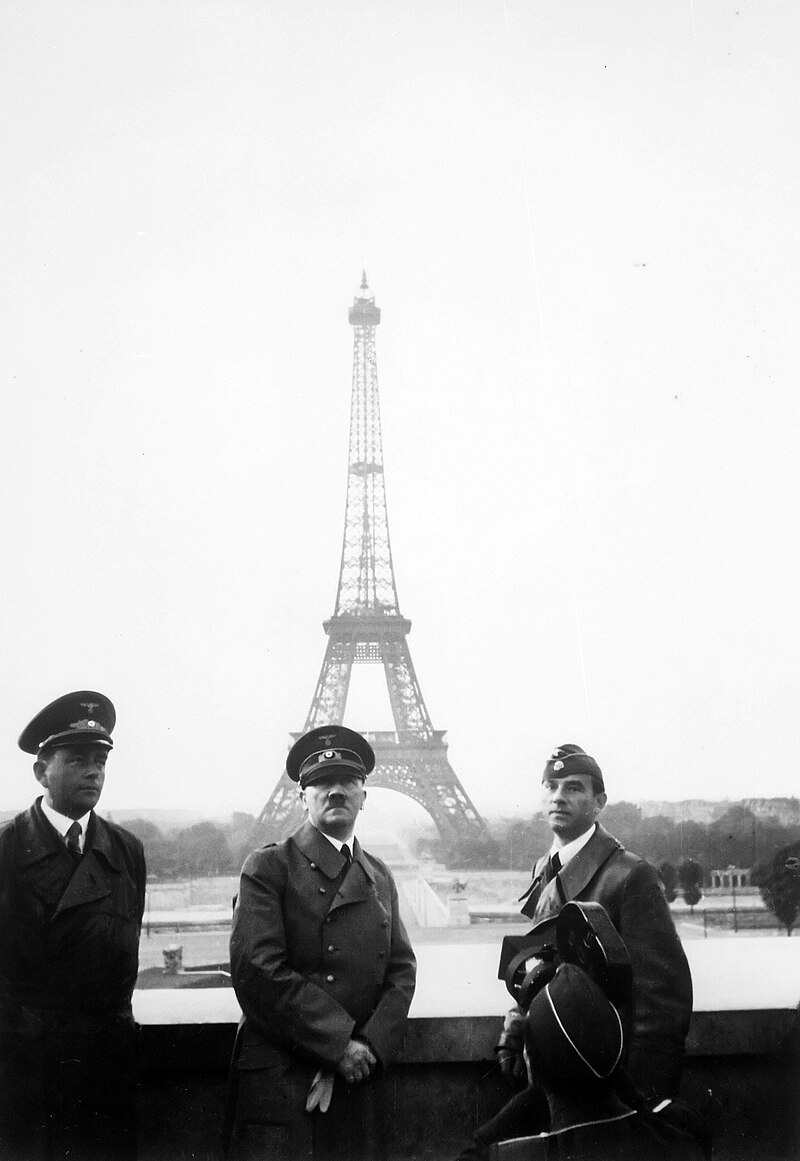 Hitler in Paris in 1940 with Speer (left) and sculptor Arno Breker During the Chancellery project, the pogrom of Kristallnacht took place. Speer made no mention of it in the first draft of Inside the Third Reich. It was only on the urgent advice of his publisher that he added a mention of seeing the ruins of the Central Synagogue in Berlin from his car.[46] Kristallnacht accelerated Speer's ongoing efforts to dispossess Berlin's Jews from their homes. From 1939 on, Speer's Department used the Nuremberg Laws to evict Jewish tenants of non-Jewish landlords in Berlin, to make way for non-Jewish tenants displaced by redevelopment or bombing.[47] Eventually, 75,000 Jews were displaced by these measures.[48] Speer denied he knew they were being put on Holocaust trains and claimed that those displaced were, "Completely free and their families were still in their apartments".[49] He also said: " ... en route to my ministry on the city highway, I could see ... crowds of people on the platform of nearby Nikolassee Railroad Station. I knew that these must be Berlin Jews who were being evacuated. I am sure that an oppressive feeling struck me as I drove past. I presumably had a sense of somber events."[49] Matthias Schmidt said Speer had personally inspected concentration camps and described his comments as an "outright farce".[50] Martin Kitchen described Speer's often repeated line that he knew nothing of the "dreadful things" as hollow—not only was he fully aware of the fate of the Jews, he actively participated in their persecution.[51] As Germany started World War II in Europe, Speer instituted quick-reaction squads to construct roads or clear away debris; before long, these units would be used to clear bomb sites.[52] Speer used forced Jewish labor on these projects, in addition to regular German workers.[53] Construction stopped on the Berlin and Nüremberg plans at the outbreak of war. Though stockpiling of materials and other work continued, this slowed to a halt as more resources were needed for the armament industry.[54] Speer's offices undertook building work for each branch of the military, and for the SS, using slave labor.[53] Speer's building work made him among the wealthiest of the Nazi elite.[55] |
党の建築家、政府の役人[編集] ナチスへの参加(1931-1934年)[編集]  シュペーアはヒトラーにオーバーザルツベルクでのプロジェクトを見せる。 1931年1月、シュペーアはナチ党員を申請し、1931年3月1日に党員番号474,481番となった[16][b]同年、大恐慌の中で俸給が減少して いたため、シュペーアはテッセノフの助手の職を辞してマンハイムに移り、建築家として生計を立てることを望んだ。建築家として生計を立てることを望んだ シュペーアは、失敗した後、父親から所有物件の管理人としてのパートタイムの仕事を与えられた。1932年7月、シュペーア一家は帝国議会 選挙の前に党を助けるためにベルリンを訪れた。滞在中、彼の友人であるナチ党幹部のカール・ハンケは、ヨーゼフ・ゲッペルスにこの若い建築家を推薦し、党 本部の改築を手伝わせた。この依頼が完了すると、シュペーアはマンハイムに戻り、1933年1月にヒトラーが大統領に就任するまでそこに留まった [18]。 1933年のニュルンベルク集会の主催者はシュペーアに集会のデザインを提出するよう依頼し、シュペーアはヒトラーと初めて接触した。主催者もルドルフ・ ヘスも計画を承認するかどうか決めかねていたため、ヘスはシュペーアをヒトラーのミュンヘンのアパートに送り、承認を求めた[19]。この仕事によって シュペーアは、ナチ党の「党の集会とデモの芸術的・技術的演出委員」として、初の国家的ポストを獲得した[20]。 ヒトラーが政権を握った直後、彼は首相官邸の再建計画を立て始めた。1933年末、ヒトラーはパウル・トルーストと契約し、建物全体の改修工事を行った。 ヒトラーは、ゲッペルスのために働いて感銘を受けたシュペーアを、トルーストのために建築現場の管理に任命した[21]。首相として、ヒトラーは建物内に 住居を構え、シュペーアと建築監督官から改築の進捗状況について説明を受けるために毎日通った。シュペーアはすぐにヒトラーの側近となり、朝、散歩やお しゃべりのためにヒトラーを呼び、建築に関する相談に乗り、ヒトラーのアイデアについて話し合うことが求められた。ほとんどの日、彼は夕食に招待された [23][24]。 英語版の回顧録では、シュペーアは、彼の政治的コミットメントは単に「月会費」を払うことであったと述べている。シュペーアは、ドイツの読者はそれほど騙 されないだろうと考え、ナチ党が「新しい使命」を提供していると語った。ウィリアム・ハムシャーとのインタビューではもっと率直で、「共産主義からドイ ツ」を救うために入党したと語っている[25]。戦後は、政治にはまったく関心がなく、ほとんど偶然に入党したと主張している。第三帝国の権力者の多くが そうであったように、彼はイデオローグではなく、「本能的な反ユダヤ主義者以上のものでもなかった」[16]。歴史家のマグヌス・ブレヒトケンはシュペー アについて、彼は反ユダヤ的な公の演説はしておらず、彼の反ユダヤ主義は反ユダヤ的であった彼の行動を通して理解するのが最善であると述べている [26]。ブレヒトケンは、シュペーアの生涯を通じて、彼の中心的な動機は権力を獲得し、支配し、富を得ることであったと付け加えている[27]。 ナチスの建築家(1934-1937年)[編集] 主な記事 ナチス建築  ツェッペリントライビューンの上にある光の大聖堂 1934年1月21日にトルーストが亡くなると、シュペーアが事実上彼に代わって党の主任建築家となった。ヒトラーはシュペーアを建設総局の局長に任命 し、名目上はヘスのスタッフとなった[28]。 トルーストの死後、シュペーアが最初に請け負った仕事のひとつが、ニュルンベルクの ツェッペリンフェルト競技場であった。このスタジアムはナチスのプロパガンダ集会に使用され、レニ・リーフェンシュタールのプロパガンダ映画『意志の勝 利』にも登場する。この建物は34万人を収容することができた[29]。シュペアは、照明効果をより際立たせるためと、太り過ぎのナチスを隠すために、で きるだけ多くのイベントを夜間に開催するよう主張した[30]。さらに多くの建物が計画された。もし建設されれば、ニュルンベルクの ドイツ・スタジアムは40万人の観客を収容できただろう[29]。シュペーアは、1936年の夏季オリンピックのために建設されるオリンピック・スタジア ムのために、ヴェルナー・マーチの設計を修正した。シュペーアは1937年のパリ万国博覧会のドイツ館を設計した[32]。 ベルリンの建築総監督(1937年-1942年)[編集]。  帝国議会議事堂と ブランデンブルク門があるグローセ・ハレ(ルールハレまたはフォルクスハレとも呼ばれる)の模型 1937年1月30日、ヒトラーはシュペーアを帝国首都建築総監に任命した。ヒトラーはシュペーアにベルリン再建計画の策定を命じた。シュペーアはそれを 「南北軸」とも呼んだ[35]。大通りの北端にはフォルクスハレを建設する計画で、高さ700フィート(210メートル)を超える巨大なドーム型の集会場 で、18万人を収容できる床面積があった。大通りの南端には、高さ120メートル、凱旋門が入るほどの大きな凱旋門が計画された。シュペーアはヴォルター ズを設計チームの一員として雇い、プラハ通りを特別に担当させた[38]。1939年に第二次世界大戦が勃発したため、これらの計画は延期され、後に放棄 された[39]。  フォルクスハレの大ドームは、ヒトラーのベルリン計画の模型の上部に見ることができる。 新しい帝国首相官邸の建設計画は1934年から進められていた。1934年末には土地が購入され、1936年3月からは最初の建物が取り壊され、ヴォース 通り(Voßstraße)のスペースが確保された[41]。長いナイフの夜」の余波で、シュペーアはヴォース通りとヴィルヘルム通りの角にあったボル シッヒ宮殿を SA本部として改築するよう依頼されていた。1936年6月、彼は3万ライヒスマルクの個人的な謝礼を請求し、総統官邸は3年から4年以内に完成すると見 積もった。詳細な計画は1937年7月に完成し、1938年1月1日に新総統官邸の最初の外壁が完成した。1938年1月27日、シュペーアはヒトラーか ら全権委任状を受け取り、1939年1月1日までに新総統官邸を完成させた。ヒトラーはプロパガンダのために、1938年8月2日の上棟式で、シュペーア にその年に新議事堂を完成させるよう命じたと主張した[43]。労働力不足のため、建設労働者は10時間から12時間の交代制で働かなければならなかった [44]。親衛隊は1938年に2つの強制収容所を建設し、その収容者たちを使って建設用の石を切り出した。オラニエンブルク強制収容所の近くには、シュ ペーアの命令でレンガ工場が建設された。そこでの劣悪な環境について誰かがコメントすると、シュペーアは「イード人たちはエジプトの捕虜となっている間に レンガ作りに慣れた」と述べた[45]。 大統領は1939年1月初旬に完成した[44]。建物自体はヒトラーによって「より偉大なドイツ政治帝国の栄冠」と称えられた[44]。  1940年、ヒトラーはシュペーア(左)と彫刻家アルノ・ブレーカーとともにパリにいた。 総統官邸建設計画中に、水晶の夜の ポグロムが起こった。シュペーアは『第三帝国の内幕』の最初の草稿で、この件にはまったく触れていない。シュペーアは『第三帝国の内部』の最初の草稿で は、この出来事についてまったく触れていない。出版社の緊急の助言によって、車からベルリンの中央シナゴーグの廃墟を見たという記述を付け加えただけで あった[46]。水晶の夜は、ベルリンのユダヤ人を家から追い出そうとするシュペーアの継続的な努力を加速させた。1939年以降、シュペーアの部局は ニュルンベルク法を用いて、再開発や爆撃によって追い出された非ユダヤ人の賃借人のために、ベルリンの非ユダヤ人地主のユダヤ人賃借人を立ち退かせた [47]。 最終的に、これらの措置によって75,000人のユダヤ人が追い出された[48]。 シュペーアは、彼らがホロコースト列車に乗せられていることを知っていたことを否定し、追い出された人々は「完全に自由であり、その家族はまだアパートに いた」と主張した[49]: 「......都市高速道路で私の省庁に向かう途中、私は近くのニコラッセ駅のホームに......人々の群衆がいるのを見ることができた。避難している ベルリンのユダヤ人に違いないと思った。車で通り過ぎるとき、圧迫感に襲われたのは確かだ。マティアス・シュミットは、シュペーアが個人的に強制収容所を 視察したことがあると述べ、彼の発言を「まったくの茶番」と評した[50]。 マーティン・キッチンは、「恐ろしいこと」については何も知らなかったというシュペーアのしばしば繰り返される台詞を空虚なものだと評した-彼はユダヤ人 の運命を十分に認識していただけでなく、彼らの迫害に積極的に参加していたのである[51]。 ドイツがヨーロッパで第二次世界大戦を開始すると、シュペーアは道路建設や瓦礫撤去のために即応部隊を組織した。資材の備蓄やその他の作業は続けられた が、軍需産業のためにより多くの資源が必要とされたため、この作業は鈍化し、停止した[54]。シュペーアの事務所は、軍の各支部や親衛隊のために、奴隷 労働者を使って建築作業を請け負った[53]。シュペーアの建築作業によって、彼はナチスのエリートの中でも最も裕福な人物となった[55]。 |
| Minister of Armaments Appointment and increasing power 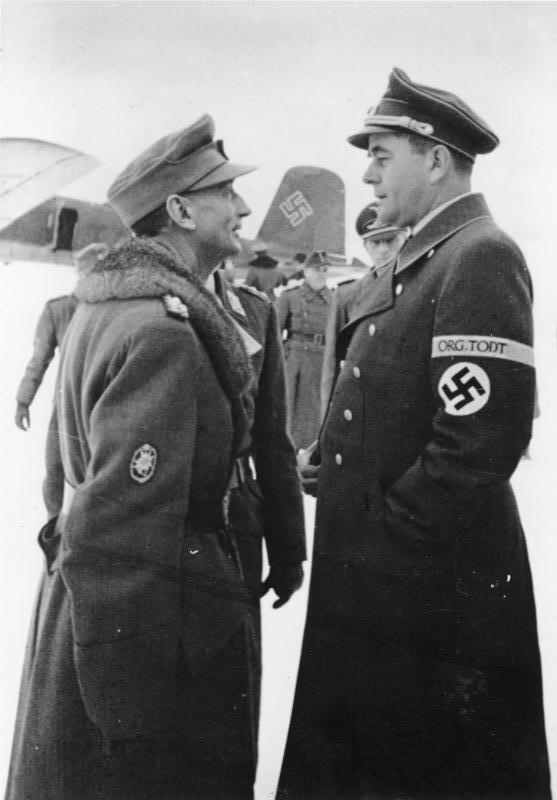 Speer (wearing Organisation Todt armband) and Wehrmacht general Eduard Dietl at Rovaniemi Airport in Finland, December 1943 As one of the younger and more ambitious men in Hitler's inner circle, Speer was approaching the height of his power. In 1938, Prussian Minister President Hermann Göring had appointed him to the Prussian State Council.[56] In 1941, he was elected to the Reichstag from electoral constituency 2 (Berlin–West).[57] On 8 February 1942, Reich Minister of Armaments and Munitions Fritz Todt died in a plane crash shortly after taking off from Hitler's eastern headquarters at Rastenburg. Speer arrived there the previous evening and accepted Todt's offer to fly with him to Berlin. Speer cancelled some hours before take-off because the previous night he had been up late in a meeting with Hitler.[58] Hitler appointed Speer in Todt's place. Martin Kitchen, a British historian, says that the choice was not surprising. Speer was loyal to Hitler, and his experience building prisoner of war camps and other structures for the military qualified him for the job.[59] Speer succeeded Todt not only as Reich Minister but in all his other powerful positions, including Inspector General of German Roadways, Inspector General for Water and Energy and Head of the Nazi Party's Office of Technology.[57] At the same time, Hitler also appointed Speer as head of the Organisation Todt, a massive, government-controlled construction company.[60] Characteristically Hitler did not give Speer any clear remit; he was left to fight his contemporaries in the regime for power and control. As an example, he wanted to be given power over all armaments issues under Göring's Four Year Plan. Göring was reluctant to grant this. However Speer secured Hitler's support, and on 1 March 1942, Göring signed a decree naming Speer "General Plenipotentiary for Armament Tasks" in the Four Year Plan.[61] Speer proved to be ambitious, unrelenting and ruthless.[62] Speer set out to gain control not just of armaments production in the army, but in the whole armed forces.[62] It did not immediately dawn on his political rivals that his calls for rationalization and reorganization were hiding his desire to sideline them and take control.[63] By April 1942, Speer had persuaded Göring to create a three-member Central Planning Board within the Four Year Plan, which he used to obtain supreme authority over procurement and allocation of raw materials and scheduling of production in order to consolidate German war production in a single agency.[64] Speer was fêted at the time, and in the post-war era, for performing an "armaments miracle" in which German war production dramatically increased. This miracle was brought to a halt in the summer of 1943 by, among other factors, the first sustained Allied bombing.[65] Other factors probably contributed to the increase more than Speer himself. Germany's armaments production had already begun to result in increases under his predecessor, Todt. Naval armaments were not under Speer's supervision until October 1943, nor the Luftwaffe's armaments until June of the following year. Yet each showed comparable increases in production despite not being under Speer's control.[66] Another factor that produced the boom in ammunition was the policy of allocating more coal to the steel industry.[67] Production of every type of weapon peaked in June and July 1944, but there was now a severe shortage of fuel. After August 1944, oil from the Romanian fields was no longer available. Oil production became so low that any possibility of offensive action became impossible and weaponry lay idle.[68] As Minister of Armaments, Speer was responsible for supplying weapons to the army.[69] With Hitler's full agreement, he decided to prioritize tank production, and he was given unrivaled power to ensure success.[70] Hitler was closely involved with the design of the tanks, but kept changing his mind about the specifications. This delayed the program, and Speer was unable to remedy the situation. In consequence, despite tank production having the highest priority, relatively little of the armaments budget was spent on it. This led to a significant German Army failure at the Battle of Prokhorovka, a major turning point on the Eastern Front against the Soviet Red Army.[71] As head of Organisation Todt, Speer was directly involved in the construction and alteration of concentration camps. He agreed to expand Auschwitz and some other camps, allocating 13.7 million Reichsmarks for the work to be carried out. This allowed an extra 300 huts to be built at Auschwitz, increasing the total human capacity to 132,000. Included in the building works was material to build gas chambers, crematoria and morgues. The SS called this "Professor Speer's Special Programme".[72] Speer realized that with six million workers drafted into the armed forces, there was a labor shortage in the war economy, and not enough workers for his factories. In response, Hitler appointed Fritz Sauckel as a "manpower dictator" to obtain new workers.[73] Speer and Sauckel cooperated closely to meet Speer's labor demands.[74] Hitler gave Sauckel a free hand to obtain labor, something that delighted Speer, who had requested 1,000,000 "voluntary" laborers to meet the need for armament workers. Sauckel had whole villages in France, Holland and Belgium forcibly rounded up and shipped to Speer's factories.[75] Sauckel obtained new workers often using the most brutal methods.[76] In occupied areas of the Soviet Union, that had been subject to partisan action, civilian men and women were rounded up en masse and sent to work forcibly in Germany.[77] By April 1943, Sauckel had supplied 1,568,801 "voluntary" laborers, forced laborers, prisoners of war and concentration camp prisoners to Speer for use in his armaments factories. It was for the maltreatment of these people, that Speer was principally convicted at the Nuremberg Trials.[78] Consolidation of arms production 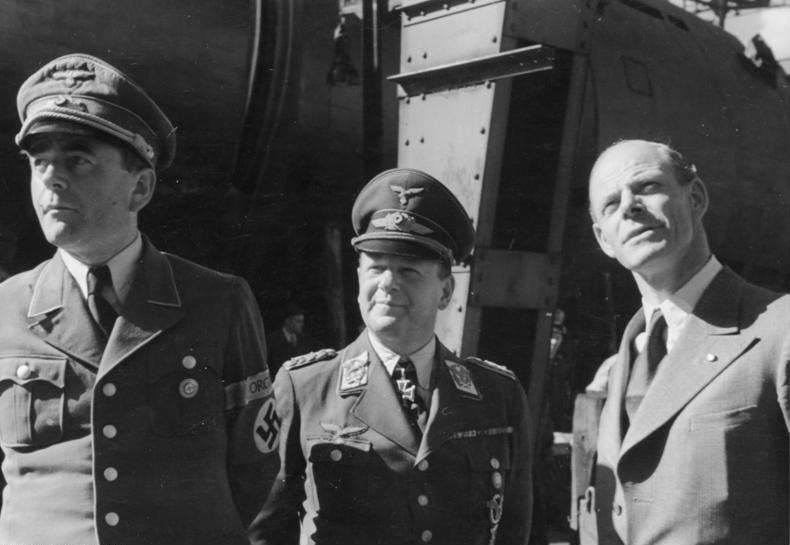 Speer with Luftwaffe field marshal Erhard Milch and aircraft designer Willy Messerschmitt, May 1944 Following his appointment as Minister of Armaments, Speer was in control of armaments production solely for the Army. He coveted control of the production of armaments for the Luftwaffe and Kriegsmarine as well. He set about extending his power and influence with unexpected ambition.[79] His close relationship with Hitler provided him with political protection, and he was able to outwit and outmaneuver his rivals in the regime. Hitler's cabinet was dismayed at his tactics, but, regardless, he was able to accumulate new responsibilities and more power.[79] By July 1943, he had gained control of armaments production for the Luftwaffe and Kriegsmarine.[80] In August 1943, he took control of most of the Ministry of Economics, to become, in Admiral Dönitz's words, "Europe's economic dictator". His formal title was changed on 2 September 1943, to "Reich Minister for Armaments and War Production". He had become one of the most powerful people in Nazi Germany.[79] Speer and his hand-picked director of submarine construction Otto Merker [de] believed that the shipbuilding industry was being held back by outdated methods, and revolutionary new approaches imposed by outsiders would dramatically improve output.[81] This belief proved incorrect, and Speer and Merker's attempt to build the Kriegsmarine's new generation of submarines, the Type XXI and Type XXIII, as prefabricated sections at different facilities rather than at single dockyards contributed to the failure of this strategically important program. The designs were rushed into production, and the completed submarines were crippled by flaws which resulted from the way they had been constructed. While dozens of submarines were built, few ever entered service.[82] In December 1943, Speer visited Organisation Todt workers in Lapland, where he seriously damaged his knee and was incapacitated for several months.[83] He was under the dubious care of Professor Karl Gebhardt at a medical clinic called Hohenlychen where patients "mysteriously failed to survive".[84] In mid-January 1944, Speer had a lung embolism and fell seriously ill. Concerned about retaining power, he did not appoint a deputy and continued to direct work of the Armaments Ministry from his bedside. Speer's illness coincided with the Allied "Big Week", a series of bombing raids on the German aircraft factories that were a devastating blow to aircraft production.[85] His political rivals used the opportunity to undermine his authority and damage his reputation with Hitler. He lost Hitler's unconditional support and began to lose power.[83] In response to the Allied Big Week, Adolf Hitler authorized the creation of a Fighter Staff committee. Its aim was to ensure the preservation and growth of fighter aircraft production. The task force was established by 1 March 1944, orders of Speer, with support from Erhard Milch of the Reich Aviation Ministry.[86] Production of German fighter aircraft more than doubled between 1943 and 1944.[87] The growth, however, consisted in large part of models that were becoming obsolescent and proved easy prey for Allied aircraft.[88] On 1 August 1944, Speer merged the Fighter Staff into a newly formed Armament Staff committee.[89] 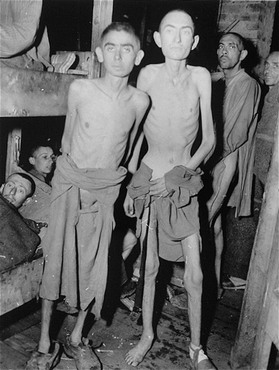 Survivors of the Mühldorf concentration camp upon liberation in 1945. Mühldorf supplied slave workers for the Weingut I project. The Fighter Staff committee was instrumental in bringing about the increased exploitation of slave labor in the war economy.[90] The SS provided 64,000 prisoners for 20 separate projects from various concentration camps including Mittelbau-Dora. Prisoners worked for Junkers, Messerschmitt, Henschel and BMW, among others.[91] To increase production, Speer introduced a system of punishments for his workforce. Those who feigned illness, slacked off, sabotaged production or tried to escape were denied food or sent to concentration camps. In 1944, this became endemic; over half a million workers were arrested.[92] By this time, 140,000 people were working in Speer's underground factories. These factories were death-traps; discipline was brutal, with regular executions. There were so many corpses at the Dora underground factory, for example, that the crematorium was overwhelmed. Speer's own staff described the conditions there as "hell".[93] The largest technological advance under Speer's command came through the rocket program. It began in 1932 but had not supplied any weaponry. Speer enthusiastically supported the program and in March 1942 made an order for A4 rockets, the predecessor of the world's first ballistic missile, the V-2 rocket. The rockets were researched at a facility in Peenemünde along with the V-1 flying bomb. The V-2's first target was Paris on 8 September 1944. The program while advanced proved to be an impediment to the war economy. The large capital investment was not repaid in military effectiveness.[94] The rockets were built at an underground factory at Mittelwerk. Labor to build the A4 rockets came from the Mittelbau-Dora concentration camp. Of the 60,000 people who ended up at the camp 20,000 died, due to the appalling conditions.[93] On 14 April 1944, Speer lost control of Organisation Todt to his deputy, Franz Xaver Dorsch.[95] He opposed the assassination attempt against Hitler on 20 July 1944. He was not involved in the plot, and played a minor role in the regime's efforts to regain control over Berlin after Hitler survived.[96] After the plot Speer's rivals attacked some of his closest allies and his management system fell out of favor with radicals in the party. He lost yet more authority.[97] Defeat of Nazi Germany 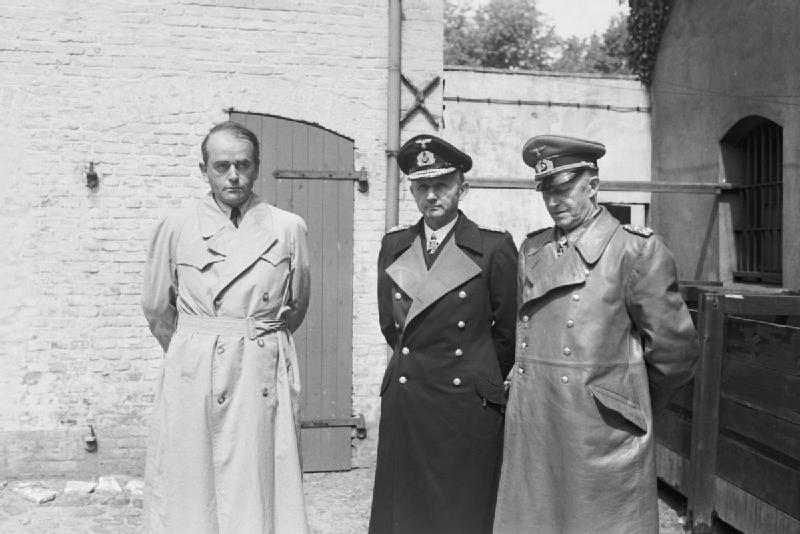 Speer (left), Karl Dönitz and Alfred Jodl (right) after their arrest by the British Army in Flensburg in Northern Germany in May 1945 Losses of territory and a dramatic expansion of the Allied strategic bombing campaign caused the collapse of the German economy from late 1944. Air attacks on the transport network were particularly effective, as they cut the main centres of production off from essential coal supplies.[98] In January 1945, Speer told Goebbels that armaments production could be sustained for at least a year.[99] However, he concluded that the war was lost after Soviet forces captured the important Silesian industrial region later that month.[100] Nevertheless, Speer believed that Germany should continue the war for as long as possible with the goal of winning better conditions from the Allies than the unconditional surrender they insisted upon.[101] During January and February, Speer claimed that his ministry would deliver "decisive weapons" and a large increase in armaments production which would "bring about a dramatic change on the battlefield".[102] Speer gained control over the railways in February, and asked Heinrich Himmler to supply concentration camp prisoners to work on their repair.[103] By mid-March, Speer had accepted that Germany's economy would collapse within the next eight weeks. While he sought to frustrate directives to destroy industrial facilities in areas at risk of capture, so that they could be used after the war, he still supported the war's continuation. Speer provided Hitler with a memorandum on 15 March, which detailed Germany's dire economic situation and sought approval to cease demolitions of infrastructure. Three days later, he also proposed to Hitler that Germany's remaining military resources be concentrated along the Rhine and Vistula rivers in an attempt to prolong the fighting. This ignored military realities, as the German armed forces were unable to match the Allies' firepower and were facing total defeat.[104][105] Hitler rejected Speer's proposal to cease demolitions. Instead, he issued the "Nero Decree" on 19 March, which called for the destruction of all infrastructure as the army retreated. Speer was appalled by this order, and persuaded several key military and political leaders to ignore it.[106] During a meeting with Speer on 28/29 March, Hitler rescinded the decree and gave him authority over demolitions.[107] Speer ended them, though the army continued to blow up bridges.[108][c] By April, little was left of the armaments industry, and Speer had few official duties.[109] Speer visited the Führerbunker on 22 April for the last time. He met Hitler and toured the damaged Chancellery before leaving Berlin to return to Hamburg.[110] Speer would later claim in his memoirs that during this visit he "confessed to Hitler [...] that he was disobeying his 'scorched-earth' policy",[111] an assertion which has been described as "pure invention"[111] by historian Richard J. Evans. On 29 April, the day before committing suicide, Hitler dictated a final political testament which dropped Speer from the successor government. Speer was to be replaced by his subordinate, Karl-Otto Saur.[112] Speer was disappointed that Hitler had not selected him as his successor.[113] After Hitler's death, Speer offered his services to Hitler's successor, Karl Dönitz.[114] On 2 May, Dönitz asked Lutz Graf Schwerin von Krosigk to form a new government, and discussions went on about the formation of the administration for the next few days. On May 5, Schwerin von Krosigk presented his cabinet (known as the Flensburg government) and Speer was named as Minister of Industry and Production.[115] Speer provided information to the Allies, regarding the effects of the air war, and on a broad range of subjects, beginning on 10 May. On 23 May, two weeks after the surrender of German forces, British troops arrested the members of the Flensburg Government and brought Nazi Germany to a formal end.[116] |
軍需大臣[編集] 任命と増大する権力[編集]  シュペーア(組織トッドの腕章を着用)と国防軍大将エドゥアルド・ディートル(1943年12月、フィンランドのロヴァニエミ空港にて ヒトラーの側近の中でも若く野心的だったシュペーアは、権力の頂点に近づいていた。1938年、プロイセンの大臣 ヘルマン・ゲーリング大統領はシュペーアをプロイセン国家評議会に任命した[56]。1941年、シュペーアは選挙区2(ベルリン=西)から帝国議会議員 に選出された[57]。1942年2月8日、フリッツ・トッド 帝国軍需大臣がヒトラーの東部司令部 ラステンブルクを離陸した直後に飛行機事故で死亡した。シュペーアは前日の夜に同地に到着し、ベルリンまで一緒に飛ぶというトッドの申し出を受け入れた。 ヒトラーはトッドの代わりにシュペールを任命した[58]。イギリスの歴史家マーティン・キッチンは、この人選は驚くべきものではなかったと言う。シュ ペールはヒトラーに忠実であり、軍のために捕虜収容所やその他の建造物を建設した経験があったため、この職務に適任であった[59]。シュペールはトッド の後任として帝国大臣に就任しただけでなく、ドイツ道路監察総監、水・エネルギー監察総監、ナチ党技術局長など、他のすべての有力な役職も引き継いだ。 [57]同時にヒトラーはシュペーアを、政府が管理する巨大な建設会社であるトド組織の長に任命した[60]。特徴的なのは、ヒトラーがシュペーアに明確 な権限を与えなかったことである。例えば、シュペーアは、ゲーリングの4カ年計画のもとで、軍備に関するすべての権限を与えられたがっていた。ゲーリング はこれを認めようとしなかった。しかし、シュペーアはヒトラーの支持を取り付け、1942年3月1日、ゲーリングはシュペーアを4カ年計画における「軍備 業務担当全権大使」に任命する勅令に署名した[61]。 シュペーアは野心家で、容赦がなく、冷酷であることが証明された[62]。 シュペーアは陸軍における軍備生産だけでなく、全軍における軍備生産の統制権を獲得しようとした。 [1942 年 4 月までに、シュペーアはゲーリングを説得して、4 カ年計画の中に 3 名の委員からなる中央計画委員会を創設させ、ドイツの戦争生産を単一の機関に統合するために、原材料の調達と配分、生産スケジューリングの最高権限を得る ために利用した[64]。 シュペーアは、ドイツの戦争生産が劇的に増加した「軍備の奇跡」を起こしたとして、当時も戦後ももてはやされた。この奇跡は 1943 年夏、とりわけ連合国による 初の持続的空爆によって停止した[65]。ドイツの軍需生産は、シュペーアの前任者であるトッドの下ですでに増加し始めていた。海軍軍備は 1943 年 10 月まで、ドイツ空軍軍備は翌年 6 月までシュペーアの監督下になかった。しかし、シュペーアの管理下になかったにもかかわらず、それぞれ同程度の増産を示した[66]。弾薬の好況を生み出 したもう一つの要因は、石炭を鉄鋼業により多く割り当てる政策であった[67]。1944 年 8 月以降、ルーマニアの油田からの石油は入手できなくなった。石油の生産量があまりにも少なくなったため、攻撃行動の可能性は不可能となり、兵器は休眠状態 に陥った[68]。 シュペーアは軍需大臣として、陸軍への兵器供給を担当していた[69]。ヒトラーの全面的な同意のもと、戦車生産を優先することを決定し、成功を確実にす るための無比の権力を与えられた[70]。ヒトラーは戦車の設計に深く関与していたが、仕様について考えを変え続けていた。そのため計画は遅れ、シュペー アは状況を改善することができなかった。その結果、戦車生産は最優先事項であったにもかかわらず、軍備予算は比較的わずかしか使われなかった。これが、ソ 連赤軍に対する 東部戦線の大きな転換点であったプロホロフカの戦いでのドイツ軍の大きな失敗につながった[71]。 シュペアはトド組織長として、強制収容所の建設と改造に直接関与した。彼はアウシュヴィッツと他のいくつかの収容所の拡張に同意し、そのために1370万 ライヒスマルクを割り当てた。これによって、アウシュヴィッツに300の小屋が追加建設され、収容人員は132,000人に増加した。この建築工事には、 ガス室、火葬場、死体安置室を建設するための資材も含まれていた。SSはこれを「シュペーア教授の特別計画」と呼んでいた[72]。 シュペーアは、600万人の労働者が軍隊に徴兵されたため、戦争経済では労働力が不足し、自分の工場に十分な労働者がいないことに気づいた。ヒトラーは、 新たな労働者を確保するために、フリッツ・ザウケルを「人手独裁者」に任命した[73]。シュペールとザウケルは、シュペールの労働力要求を満たすために 緊密に協力した[74]。ザウケルはフランス、オランダ、ベルギーの村落全体を強制的に検挙し、シュペーアの工場に送らせた[75]。 [77]1943年4月までに、ザウケルは、軍需工場で使用するために、156万8,801人の「自発的」労働者、強制労働者、戦争捕虜、強制収容所囚人 をシュペーアに供給した。ニュルンベルク裁判でシュペーアが主に有罪判決を受けたのは、これらの人々に対する虐待のためであった[78]。 兵器生産の統合[編集]  シュペーアとドイツ空軍野戦司令官エアハルト・ミルヒ、航空機設計者ウィリー・メッサーシュミット(1944年5月) 軍需大臣に任命されたシュペーアは、陸軍のための軍需生産のみを管理していた。シュペーアは、ドイツ空軍と ドイツ海軍の軍需生産も管理したいと考えた。ヒトラーとの親密な関係は彼に政治的保護を与え、政権内のライバルを出し抜き、巧みに操ることができた。 1943年7月までに、彼はドイツ空軍と ドイツ海軍の軍需生産を掌握した[80]。 1943年8月、彼は経済省の大部分を掌握し、デーニッツ提督の言葉を借りれば「ヨーロッパの経済独裁者」となった。正式名称は1943年9月2日に「帝 国軍需・戦争生産大臣」に変更された。彼はナチス・ドイツで最も権力を持つ人物の一人となった[79]。 シュペーアと彼が指名した潜水艦建造の責任者オットー・メルカー[デ]は、造船産業が時代遅れの方法によって抑制されており、外部者によってもたらされる 革命的な新しいアプローチが生産高を劇的に向上させると信じていた[81]。この信念は誤りであることが証明され、シュペーアとメルカーは、クリーグズ マーリンの新世代潜水艦であるタイプXXIと タイプXXIIIを、単一の造船所ではなく異なる施設でプレハブとして建造しようとしたことが、この戦略的に重要な計画の失敗につながった。設計は急いで 生産に移され、完成した潜水艦は建造方法から生じた欠陥によって不具合を生じた。何十隻もの潜水艦が建造されたが、就役したものはほとんどなかった [82]。 1943年12月、シュペーアはラップランドにある組織トッドの労働者を訪ねたが、そこで膝に深刻な損傷を負い、数ヶ月間動けなくなった[83]。 彼はホーエンライヒェンと呼ばれる診療所でカール・ゲバルト教授の怪しげな治療を受けたが、そこでは「不思議なことに患者が生き残ることができなかった」 [84]。権力を維持することを懸念したシュペーアは副官を任命せず、枕元で軍需省の仕事を指揮し続けた。シュペーアの病気は、航空機生産に壊滅的な打撃 を与えたドイツの航空機工場への一連の空襲である連合軍の「ビッグウィーク」と重なった[85]。彼の政敵はこの機会を利用して彼の権威を失墜させ、ヒト ラーに対する彼の評判を傷つけた。彼はヒトラーの無条件の支持を失い、権力を失い始めた[83]。 連合軍のビッグウィークを受け、アドルフ・ヒトラーは 戦闘機参謀委員会の設立を許可した。その目的は、戦闘機生産の維持と拡大を確保することであった。このタスクフォースはシュペーアの命令により、帝国航空 省のエアハルト・ミルヒの支援を受けて1944年3月1日までに設立された[86]。 ドイツの戦闘機の生産は1943年から1944年にかけて2倍以上に増加した[87]。 しかし、この増加は陳腐化しつつあり、連合軍機の格好の餌食となった機種が大部分を占めていた[88]。  1945年解放時のミュールドルフ強制収容所の生存者。ミュールドルフはヴァイングートI計画に奴隷労働者を供給していた。 戦闘機参謀委員会は、戦争経済における奴隷労働の搾取の拡大をもたらすのに貢献した[90]。SSは、ミッテルバウ・ドーラを含む様々な強制収容所から、 20の個別のプロジェクトに64,000人の囚人を提供した。囚人たちはユンカース、メッサーシュミット、ヘンシェル、BMWなどのために働いた [91]。生産を増加させるために、シュペアは労働者に対する処罰制度を導入した。病気を装ったり、怠けたり、生産を妨害したり、逃亡を図ったりした者 は、食事を拒否されたり、強制収容所に送られたりした。1944年には、これが常態化し、50万人以上の労働者が逮捕された[92]。この時までに、14 万人がシュペーアの地下工場で働いていた。これらの工場は死の罠であり、規律は残忍で、定期的に処刑が行われた。たとえば、ドーラ地下工場では火葬場が満 杯になるほど多くの死体が出た。シュペーア自身のスタッフは、そこでの状況を「地獄」と表現した[93]。 シュペーアの指揮下で最大の技術的進歩はロケット計画によってもたらされた。この計画は1932年に始まったが、兵器は供給されていなかった。シュペーア はこの計画を熱心に支援し、1942年3月、世界初の弾道ミサイルであるV-2ロケットの前身であるA4ロケットを発注した。このロケットは、V-1飛行 爆弾とともに ペーネミュンデの施設で研究された。V-2の最初の標的は1944年9月8日のパリだった。この計画は先進的ではあったが、戦争経済にとっては障害となっ た。ロケットはミッテルヴェルクの地下工場で製造された。A4ロケットを製造するための労働力はミッテルバウ・ドーラ強制収容所からもたらされた。収容所 に収容された60,000人のうち20,000人が、ひどい環境のために死亡した[93]。 1944年4月14日、シュペアは組織トッドの指揮権を副官フランツ・クサヴァー・ドルシュに奪われた[95]。1944年7月20日のヒトラー暗殺未遂 事件に反対した。シュペーのライバルたちは彼の親しい同盟者を攻撃し、彼の管理体制は党内の急進派から支持されなくなった。彼はさらに権威を失った [97]。 ナチス・ドイツの敗北[編集]  1945年5月、北ドイツのフレンスブルクでイギリス軍に逮捕されたシュペーア(左)、カール・デーニッツ、アルフレッド・ヨードル(右)。 領土の喪失と連合軍の戦略爆撃作戦の劇的な拡大は、1944年後半からドイツ経済の崩壊を引き起こした。1945年1月、シュペーアはゲッベルスに対し、 軍需生産は少なくとも1年間は維持できると述べた[99]。 しかし、同月末にソ連軍が重要なシレジア工業地帯を占領したため、シュペーアは戦争は敗北したと結論づけた[100]。 [それにもかかわらず、シュペーアは、ドイツは連合国が主張する無条件降伏よりも有利な条件を連合国から勝ち取ることを目標に、可能な限り長く戦争を続け るべきだと考えていた[101]。 1月から2月にかけて、シュペーアは自分の省が「決定的な兵器」と「戦場に劇的な変化をもたらす」軍需生産の大幅な増加をもたらすと主張した[102]。 シュペーアは2月に鉄道を掌握し、強制収容所の囚人たちに鉄道の修理に従事させるようハインリヒ・ヒムラーに要請した[103]。 3月中旬までに、シュペーアはドイツ経済が今後8週間以内に崩壊することを受け入れていた。シュペーアは、捕虜となる危険のある地域の工業施設を破壊し、 戦後も使用できるようにする指令を頓挫させようとしたが、それでも戦争の継続を支持した。シュペーアは3月15日にヒトラーに覚書を提出し、ドイツの悲惨 な経済状況を詳細に説明し、インフラストラクチャーの取り壊しを中止する承認を求めた。その3日後、シュペーアはヒトラーに、ドイツの残りの軍事資源をラ イン川とヴィスワ川に集中させ、戦闘を長引かせることを提案した。これは軍事的現実を無視したものであり、ドイツ軍は連合軍の火力に敵わず、完全な敗北に 直面していたからである[104][105]。ヒトラーはシュペーアの解体中止の提案を拒否した。その代わりに、ヒトラーは3月19日に「ネロ命令」を発 し、軍隊の撤退に伴ってすべてのインフラストラクチャーを破壊するよう求めた。シュペーアはこの命令に愕然とし、これを無視するよう何人かの主要な軍部指 導者や政治指導者を説得した[106]。3月28日と29日に行われたシュペーアとの会談で、ヒトラーは命令を取り消し、解体に関する権限をシュペーアに 与えた[107]。 4月になると軍需産業はほとんどなくなり、シュペーアはほとんど公務を行わなくなった[109]。4月22日、シュペーアは最後にフューラーバンカーを訪 れた。シュペーアは後に回顧録の中で、この訪問中に「ヒトラーに[...]自分が彼の『焦土化』政策に背いていることを告白した」と主張するが [111]、この主張は歴史家のリチャード・J・エヴァンスによって「純粋な作り話」と評されている[111]。4月29日、ヒトラーは自殺する前日に、 シュペーアを後継政府から外すという最後の政治的遺言を口述した。ヒトラーの死後、シュペーアはヒトラーの後継者であるカール・デーニッツに助力を申し出 た[114]。 5月2日、デーニッツはルッツ・グラーフ・シュヴェリン・フォン・クローシヒクに新政権の樹立を要請し、その後数日間、政権樹立に関する話し合いが行われ た。5月5日、シュヴェリン・フォン・クロシグクは内閣(フレンスブルク政府として知られる)を提出し、シュペーアは産業・生産大臣に任命された [115]。シュペーアは5月10日から、連合国に対して、航空戦争の影響や幅広いテーマに関する情報を提供した。ドイツ軍の降伏から2週間後の5月23 日、イギリス軍はフレンスブルク政府のメンバーを逮捕し、ナチス・ドイツは正式に終結した[116]。 |
| Post-war Nuremberg trial Main article: Nuremberg trials 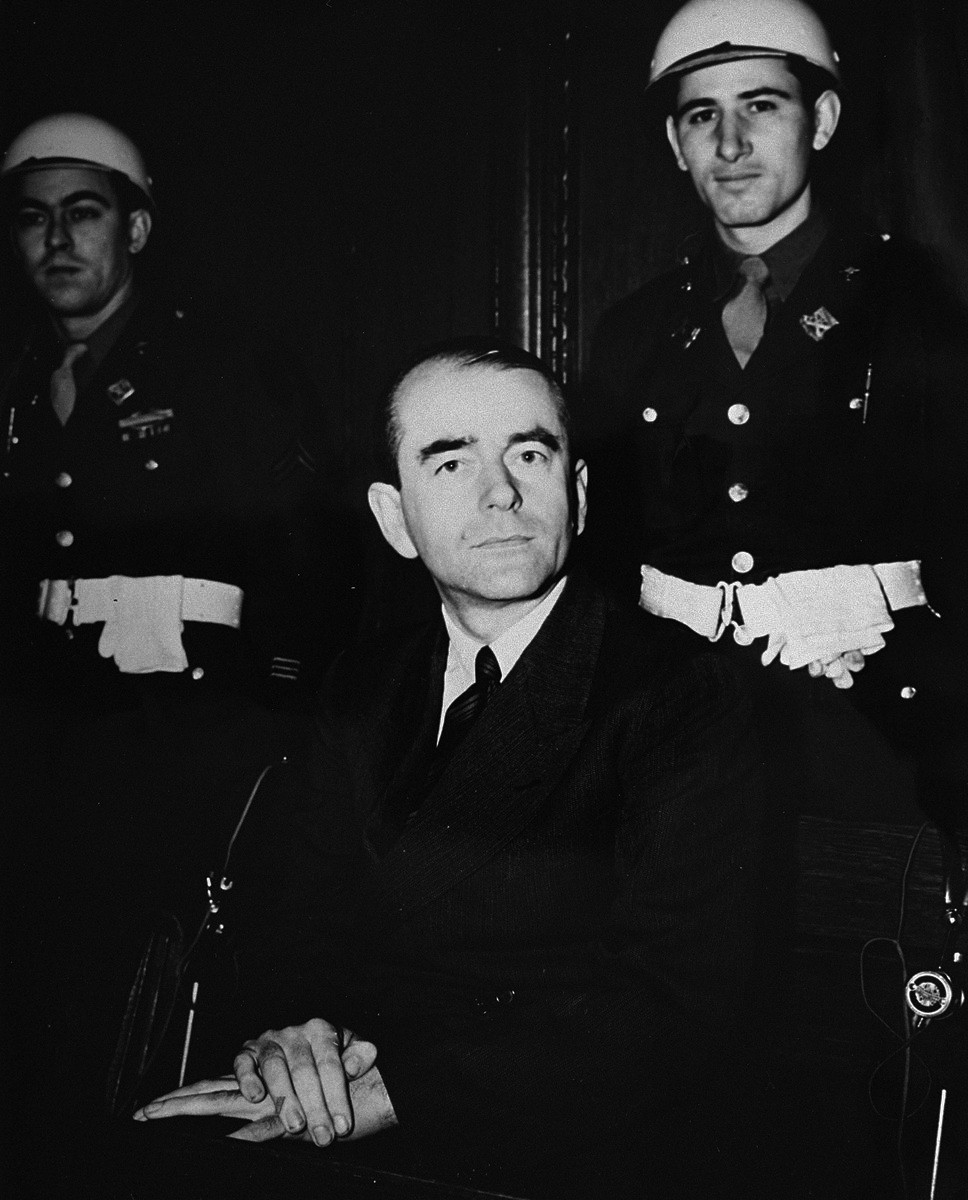 Speer at the Nuremberg trial Speer was taken to several internment centres for Nazi officials and interrogated. In September 1945, he was told that he would be tried for war crimes, and several days later, he was moved to Nuremberg and incarcerated there.[117] Speer was indicted on four counts: participating in a common plan or conspiracy for the accomplishment of crime against peace; planning, initiating and waging wars of aggression and other crimes against peace; war crimes; and crimes against humanity.[118] The chief United States prosecutor, Robert H. Jackson, of the U.S. Supreme Court said, "Speer joined in planning and executing the program to dragoon prisoners of war and foreign workers into German war industries, which waxed in output while the workers waned in starvation."[119] Speer's attorney, Hans Flächsner, successfully contrasted Speer from other defendants[120] and portrayed him as an artist thrust into political life who had always remained a non-ideologue.[121] Speer was found guilty of war crimes and crimes against humanity, principally for the use of slave labor and forced labor. He was acquitted on the other two counts. He had claimed that he was unaware of Nazi extermination plans, and the Allies had no proof that he was aware. His claim was revealed to be false in a private correspondence written in 1971 and publicly disclosed in 2007.[122] On 1 October 1946, he was sentenced to 20 years' imprisonment.[123] While three of the eight judges (two Soviet and American Francis Biddle) advocated the death penalty for Speer, the other judges did not, and a compromise sentence was reached after two days of discussions.[124] Imprisonment On 18 July 1947, Speer was transferred to Spandau Prison in Berlin to serve his prison term.[125] There he was known as Prisoner Number Five.[126] Speer's parents died while he was incarcerated. His father, who died in 1947, despised the Nazis and was silent upon meeting Hitler. His mother died in 1952. As a Nazi Party member, she had greatly enjoyed dining with Hitler.[5] Wolters and longtime Speer secretary Annemarie Kempf, while not permitted direct communication with Speer in Spandau, did what they could to help his family and carry out the requests Speer put in letters to his wife—the only written communication he was officially allowed. Beginning in 1948, Speer had the services of Toni Proost, a sympathetic Dutch orderly, to smuggle mail and his writings.[127] 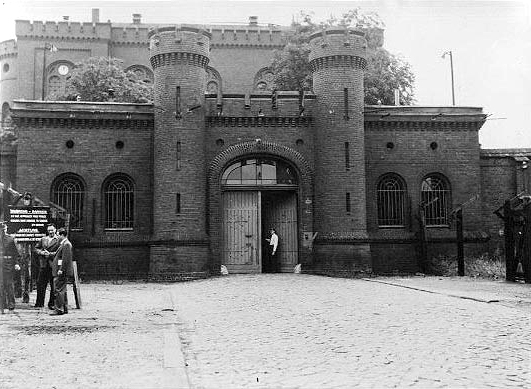 Speer spent most of his sentence at Spandau Prison. In 1949, Wolters opened a bank account for Speer and began fundraising among those architects and industrialists who had benefited from Speer's activities during the war. Initially, the funds were used only to support Speer's family, but increasingly the money was used for other purposes. They paid for Toni Proost to go on holiday, and for bribes to those who might be able to secure Speer's release. Once Speer became aware of the existence of the fund, he sent detailed instructions about what to do with the money.[127] Wolters raised a total of DM158,000 for Speer over the final seventeen years of his sentence.[128] The prisoners were forbidden to write memoirs. Speer was able to have his writings sent to Wolters, however, and they eventually amounted to 20,000 pages.[129] He had completed his memoirs by November 1953, and they became the basis of Inside the Third Reich.[130] In Spandau Diaries, Speer aimed to present himself as a tragic hero who had made a Faustian bargain for which he endured a harsh prison sentence.[131] Much of Speer's energy was dedicated to keeping fit, both physically and mentally, during his long confinement.[132] Spandau had a large enclosed yard where inmates were allocated plots of land for gardening. Speer created an elaborate garden complete with lawns, flower beds, shrubbery, and fruit trees.[133] To make his daily walks around the garden more engaging Speer embarked on an imaginary trip around the globe. Speer started his “walk” from Berlin and went eastward across the entirety of Eurasia, crossed the Bering Strait into Alaska and then traveled south down the west coast of North America. Carefully measuring distance travelled each day, he mapped distances to the real-world geography. He had walked more than 30,000 kilometres (19,000 mi), ending his sentence near Guadalajara, Mexico.[134] Speer also read, studied architectural journals, and brushed up on English and French. In his writings, Speer claimed to have finished five thousand books while in prison. His sentence of twenty years amounted to 7,305 days, which only allotted one and a half days per book.[135] Speer's supporters maintained calls for his release. Among those who pledged support for his sentence to be commuted were Charles de Gaulle and US diplomat George Wildman Ball.[136] Willy Brandt was an advocate of his release,[137] putting an end to the de-Nazification proceedings against him,[138] which could have caused his property to be confiscated.[139] Speer's efforts for an early release came to naught. The Soviet Union, having demanded a death sentence at trial, was unwilling to entertain a reduced sentence.[140] Speer served a full term and was released at midnight on 1 October 1966.[141] Release and later life Speer's release from prison was a worldwide media event. Reporters and photographers crowded both the street outside Spandau and the lobby of the Hotel Berlin where Speer spent the night.[142] He said little, reserving most comments for a major interview published in Der Spiegel in November 1966.[143] Although he stated he hoped to resume an architectural career, his sole project, a collaboration for a brewery, was unsuccessful.[15] Instead, he revised his Spandau writings into two autobiographical books, Inside the Third Reich (in German, Erinnerungen, or Reminiscences[144]) and Spandau: The Secret Diaries. He later published a work about Himmler and the SS which has been published in English as The Slave State: Heinrich Himmler's Masterplan for SS Supremacy or Infiltration: How Heinrich Himmler Schemed to Build an SS Industrial Empire (in German, Der Sklavenstaat - Meine Auseinandersetzung mit der SS). Speer was aided in shaping the works by Joachim Fest and Wolf Jobst Siedler from the publishing house Ullstein.[145] He found himself unable to re-establish a relationship with his children, even with his son Albert who had also become an architect. According to Speer's daughter Hilde Schramm, "One by one my sister and brothers gave up. There was no communication."[146] He supported Hermann, his brother, financially after the war. However, his other brother Ernst had died in the Battle of Stalingrad, despite repeated requests from his parents for Speer to repatriate him.[5] Following his release from Spandau, Speer donated the Chronicle, his personal diary, to the German Federal Archives. It had been edited by Wolters and made no mention of the Jews.[147] David Irving discovered discrepancies between the deceptively edited Chronicle and independent documents. Speer asked Wolters to destroy the material he had omitted from his donation but Wolters refused and retained an original copy.[148] Wolters' friendship with Speer deteriorated, and one year before Speer's death, Wolters gave Matthias Schmidt access to the unedited Chronicle. Schmidt authored the first book highly critical of Speer.[149] Speer's memoirs were a phenomenal success. The public was fascinated by an inside view of the Third Reich and a major war criminal became a popular figure almost overnight. Importantly, he provided an alibi to older Germans who had been Nazis. If Speer, who had been so close to Hitler, had not known the full extent of the crimes of the Nazi regime and had just been "following orders", then they could tell themselves and others they too had done the same.[150] So great was the need to believe this "Speer Myth" that Fest and Siedler were able to strengthen it—even in the face of mounting historical evidence to the contrary.[151] Death 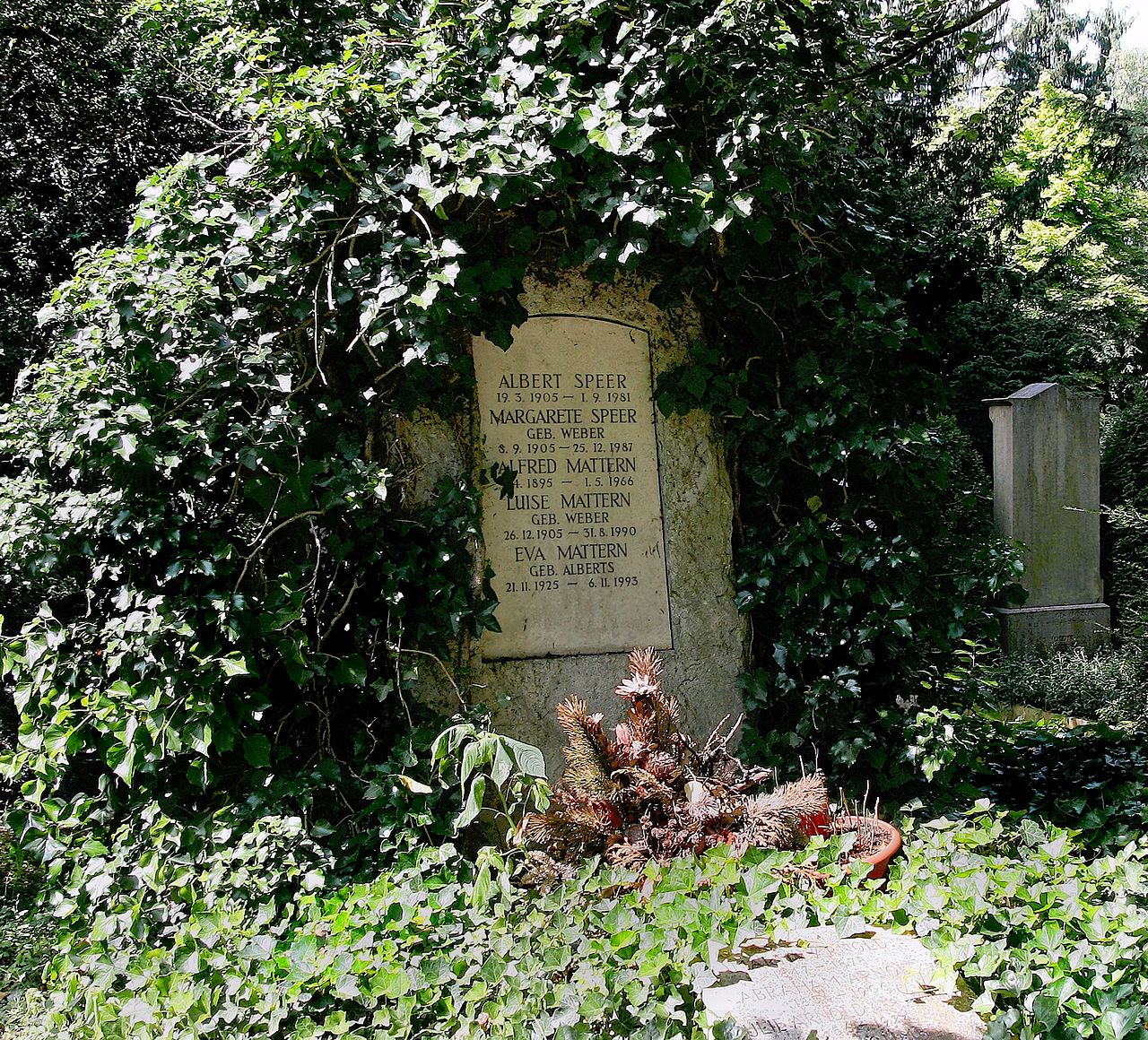 Speer's grave in Heidelberg Speer made himself widely available to historians and other enquirers.[152] In October 1973, he made his first trip to Britain, flying to London to be interviewed on the BBC Midweek programme.[153] In the same year, he appeared on the television programme The World at War. Speer returned to London in 1981 to participate in the BBC Newsnight programme. He suffered a stroke and died in London on 1 September.[154] He had remained married to his wife, but he had formed a relationship with a German woman living in London and was with her at the time of his death.[155] His daughter, Margret Nissen, wrote in her 2005 memoirs that after his release from Spandau he spent all of his time constructing the "Speer Myth".[156] |
戦後[編集] ニュルンベルク裁判[編集] 主な記事 ニュルンベルク裁判  ニュルンベルク裁判でのシュペーア シュペーアはナチス高官の収容所数か所に連行され、尋問を受けた。1945年9月、彼は戦争犯罪で裁かれることを告げられ、数日後、ニュルンベルクに移さ れ、そこに収監された[117]。シュペールは4つの訴因で起訴された:平和に対する犯罪を達成するための共通の計画または陰謀への参加、侵略戦争および その他の平和に対する犯罪の計画、開始、遂行、戦争犯罪、人道に対する罪[118]。 合衆国最高裁判所の主任検事ロバート・H・ジャクソンは、「シュペールは捕虜と外国人労働者をドイツの戦争産業に引きずり込むプログラムの計画と実行に加 わった。 シュペーアは、主に奴隷労働と強制労働の使用に対する戦争犯罪と人道に対する罪で有罪となった。他の2つの罪状については無罪となった。シュペーアはナチ スの絶滅計画を知らなかったと主張しており、連合国側も彼が知っていたという証拠はなかった。1946年10月1日、彼は20年の禁固刑を言い渡された [123]。 8人の裁判官のうち3人(2人のソ連人とアメリカ人のフランシス・ビドル)はシュペーアに対する死刑を主張したが、他の裁判官はそうせず、2日間の話し合 いの後、妥協的な判決が下された[124]。 投獄[編集] 1947年7月18日、シュペーアは服役のためベルリンのシュパンダウ刑務所に移送された[125]。そこで彼は囚人番号5として知られていた [126]。1947年に亡くなった父親はナチスを軽蔑しており、ヒトラーに会っても沈黙していた。母親は1952年に亡くなった。ヴォルターズと長年の シュペーア秘書アンネマリー・ケンプフは、シュペーアとシュパンダウで直接連絡を取ることは許されなかったが、シュペーアの家族を助け、シュペーアが妻に 宛てた手紙(シュペーアが公式に許された唯一の文書による連絡)に書いた要求を実行するためにできる限りのことをした[5]。1948年から、シュペーア は、同情的なオランダ人の命令係であるトニ・プロスト(Toni Proost)を使って、郵便物と彼の著作物を密輸していた[127]。  シュペアは刑期のほとんどをシュパンダウ刑務所で過ごした。 1949年、ヴォルタースはシュペーアのために銀行口座を開設し、戦時中にシュペーアの活動から利益を得た建築家や実業家の間で資金集めを始めた。当初、 資金はシュペーアの家族を支援するためだけに使われたが、次第に他の目的にも使われるようになった。トニ・プロストが休暇を過ごすための費用や、シュペー アの釈放を確保できそうな人物への賄賂に使われた。シュペーアが基金の存在を知ると、彼はその金の使い道について詳細な指示を送った[127]。ヴォル ターズは、シュペーアのために、刑期の最後の17年間で合計158,000ドイツマルクを集めた[128]。 囚人は回想録を書くことを禁じられていた。シュペーアは1953年11月までに手記を完成させ、『第三帝国の内部』の基礎となった[130]。シュペーア は『シュパンダウ日記』において、過酷な懲役刑に耐えるためにファウスト的な取引をした悲劇のヒーローとして自らを表現することを目指した[131]。 シュペーアのエネルギーの多くは、長い収監期間中、肉体的にも精神的にも健康を維持することに捧げられた[132]。シュパンダウには広い囲われた庭があ り、受刑者には園芸用の区画が割り当てられていた。シュペーアは、芝生、花壇、低木、果樹を完備した手の込んだ庭を作った[133]。シュペーアは、毎日 の庭の散歩をより魅力的なものにするために、地球一周の架空の旅に出た。シュペアはベルリンから「散歩」を始め、ユーラシア大陸を東に横断し、ベーリング 海峡を越えてアラスカに入り、北アメリカ西海岸を南下した。毎日慎重に移動距離を測り、現実の地理と距離を対応させた。彼は30,000キロメートル (19,000マイル)以上を歩き、メキシコのグアダラハラ近郊で旅を終えた[134]。スピアーはまた、読書、建築雑誌の研究、英語とフランス語のブ ラッシュアップも行った。シュペアは著作の中で、獄中で5000冊の本を読み終えたと主張している。20年の刑期は7,305日に相当し、1冊につき1日 半しか割り当てられていなかった[135]。 シュペーアの支持者たちは彼の釈放を求め続けた。減刑を支持することを表明した人物の中には、シャルル・ド・ゴールやアメリカの外交官ジョージ・ワイルド マン・ボールもいた[136]。ヴィリー・ブラントはシュペールの釈放を支持し[137]、彼の財産が没収される可能性があったシュペールに対する脱ナチ ス化手続きに終止符を打った[138]。裁判で死刑判決を要求したソ連は減刑を受け入れようとしなかった[140]。シュペーアは全期間服役し、1966 年10月1日午前0時に釈放された[141]。 釈放とその後の生活[編集] シュペーアの釈放は世界的なメディアイベントとなった。シュパンダウの外の通りにも、シュペーアが一夜を過ごしたホテル・ベルリンのロビーにも記者やカメ ラマンが押し寄せた[142]。シュペーアはほとんど何も語らず、ほとんどのコメントを1966年11月に『シュピーゲル』誌に掲載された主要なインタ ビューのために留保した[143]: 秘密の日記』である。その後、彼はヒムラーと親衛隊に関する著作を発表し、それは『奴隷国家』として英語で出版されている: ハインリヒ・ヒムラーのSS覇権マスタープラン』または『潜入』として英語で出版されている: ドイツ語では『Der Sklavenstaat - Meine Auseinandersetzung mit der SS』)である。シュペーアは、出版社ウルシュタインの ヨアヒム・フェストと ヴォルフ・ヨブスト・シードラーに助けられながら、この著作を執筆した[145]。シュペアの娘ヒルデ・シュラムによれば、「姉や兄たちは次々と諦めて いった。シュペアは戦後、兄のヘルマンを経済的に支援した。しかし、もう一人の兄エルンストは、シュペーアに送還を求める両親の再三の要請にもかかわら ず、スターリングラードの戦いで戦死していた[5]。 シュパンダウからの釈放後、シュペアは個人的な日記である『クロニクル』をドイツ連邦公文書館に寄贈した。それはヴォルタースによって編集されたもので、 ユダヤ人についての言及はなかった[147]。デイヴィッド・アーヴィングは、欺瞞的に編集された『年代記』と独立した文書との間に矛盾があることを発見 した。シュペールとヴォルタースの友好関係は悪化し、シュペールが亡くなる1年前、ヴォルタースはマティアス・シュミットに未編集の『年代記』を閲覧させ た。シュミットはシュペールを強く批判する最初の本を執筆した[149]。 シュペーアの回想録は驚異的な成功を収めた。大衆は第三帝国の内幕に魅了され、一人の大戦犯がほとんど一夜にして人気者となった。重要なことは、シュペー アがナチスであった年配のドイツ人にアリバイを提供したことである。ヒトラーの近くにいたシュペーアが、ナチス政権の犯罪の全容を知らず、ただ「命令に 従っただけ」であったとすれば、彼らは自分自身や他の人々にも自分も同じことをしたと言い聞かせることができた[150]。この「シュペーア神話」を信じ る必要性が非常に高かったため、フェストとシードラーは、それに反する歴史的証拠が積み重なる中でさえ、この神話を強化することができた[151]。 死[編集]  ハイデルベルクにあるシュペーアの墓 1973年10月、シュペーアは初めてイギリスを訪れ、BBCの番組『Midweek』のインタビューを受けるためにロンドンに飛んだ[153]。シュペ アは1981年にロンドンに戻り、BBCの番組『Newsnight』に出演した。脳卒中で倒れ、9月1日にロンドンで死去した[154]。 妻とは結婚生活を続けていたが、ロンドン在住のドイツ人女性と関係を結び、死亡時には彼女と一緒にいた[155]。娘のマーグレット・ニッセンは2005 年の回顧録で、シュパンダウから釈放された後、彼は「シュペーア神話」の構築に明け暮れたと書いている[156]。 |
| The Speer myth The Good Nazi After his release from Spandau, Speer portrayed himself as the "good Nazi".[157] He was well-educated, middle class, and bourgeois, and could contrast himself with those who, in the popular mind, typified "bad Nazis".[158] In his memoirs and interviews, he had distorted the truth and made so many major omissions that his lies became known as "myths".[159] Speer even invented his own birth's circumstances, stating falsely that he was born at midday amid crashes of thunder and bells of the nearby Christ Church, whereas it was between three and five o'clock, and the church was built only some years after.[160] Speer took his myth-making to a mass media level and his "cunning apologies" were reproduced frequently in post-war Germany.[159] Isabell Trommer writes in her biography of Speer that Fest and Siedler were co-authors of Speer's memoirs and co-creators of his myths.[161] In return they were paid handsomely in royalties and other financial inducements.[162] Speer, Siedler and Fest had constructed a masterpiece; the image of the "good Nazi" remained in place for decades, despite historical evidence indicating that it was false.[163] 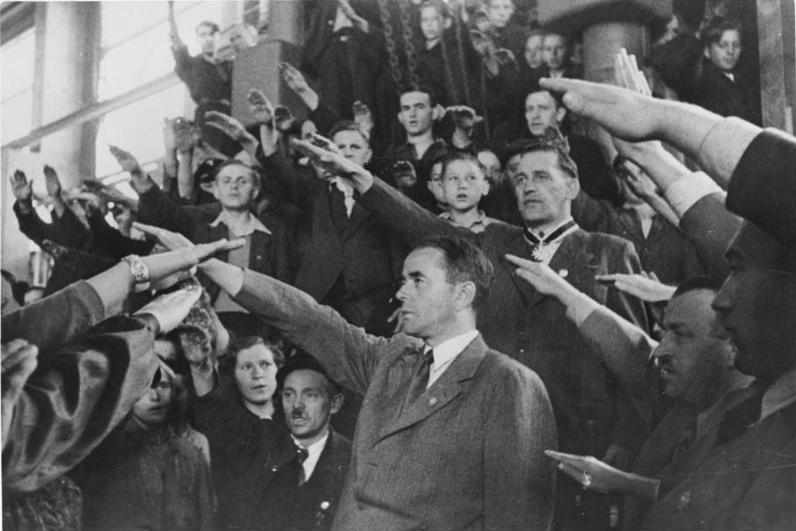 Black and white photograph of a group of men wearing business suits raising their right arms in a Nazi salute Speer during a visit to a munitions factory in May 1944 Speer had carefully constructed an image of himself as an apolitical technocrat who deeply regretted having failed to discover the monstrous crimes of the Third Reich.[164] This construction was accepted almost at face value by historian Hugh Trevor-Roper when investigating the death of Adolf Hitler for British Intelligence and in writing The Last Days of Hitler. Trevor-Roper frequently refers to Speer as "a technocrat [who] nourished a technocrat's philosophy", one who cared only for his building projects or his ministerial duties, and who thought that politics was irrelevant, at least until Hitler's Nero Decree which Speer, according to his own telling, worked assiduously to counter. Trevor-Roper – who calls Speer an administrative genius whose basic instincts were peaceful and constructive – does take Speer to task, however, for his failure to recognize the immorality of Hitler and Nazism, calling him "the real criminal of Nazi Germany":[165] For ten years he sat at the very centre of political power; his keen intelligence diagnosed the nature and observed the mutations of Nazi government and policy; he saw and despised the personalities around him; he heard their outrageous orders and understood their fantastic ambitions; but he did nothing. Supposing politics to be irrelevant, he turned aside and built roads and bridges and factories, while the logical consequences of government by madmen emerged. Ultimately, when their emergence involved the ruin of all his work, Speer accepted the consequences and acted. Then it was too late; Germany had been destroyed.[166] After Speer's death, Matthias Schmidt published a book that demonstrated that Speer had ordered the eviction of Jews from their Berlin homes.[167] By 1999, historians had amply demonstrated that Speer had lied extensively.[168] Even so, public perceptions of Speer did not change substantially until Heinrich Breloer aired the biographical film Speer und Er on TV in 2004. The film began a process of demystification and critical reappraisal.[150] Adam Tooze in his book The Wages of Destruction said Speer had manoeuvred himself through the ranks of the regime skillfully and ruthlessly and that the idea he was a technocrat blindly carrying out orders was "absurd".[169] Trommer said he was not an apolitical technocrat; instead, he was one of the most powerful and unscrupulous leaders in the Nazi regime.[162] Kitchen said he had deceived the Nuremberg Tribunal and post-war Germany.[168] Brechtken said that if his extensive involvement in the Holocaust had been known at the time of his trial he would have been sentenced to death.[26] The image of the good Nazi was supported by numerous Speer myths.[159] In addition to the myth that he was an apolitical technocrat, he claimed he did not have full knowledge of the Holocaust or the persecution of the Jews. Another myth posits that Speer revolutionized the German war machine after his appointment as Minister of Armaments. He was credited with a dramatic increase in the shipment of arms that was widely reported as keeping Germany in the war.[170] Another myth centered around a faked plan to assassinate Hitler with poisonous gas. The idea for this myth came to him after he recalled the panic when car fumes came through an air ventilation system. He fabricated the additional details.[171] Brechtken wrote that his most brazen lie was fabricated during an interview with a French journalist in 1952. The journalist described an invented scenario in which Speer had refused Hitler's orders and Hitler had left with tears in his eyes. Speer liked the scenario so much that he wrote it into his memoirs. The journalist had unwittingly collaborated in one of his myths.[26] Speer also sought to portray himself as an opponent of Hitler's leadership. Despite his opposition to the 20 July plot, he falsely claimed in his memoirs to have been sympathetic to the plotters. He maintained Hitler was cool towards him for the remainder of his life after learning they had included him on a list of potential ministers. This formed a key element of the myths Speer encouraged.[172] Speer also falsely claimed that he had realised the war was lost at an early stage, and thereafter worked to preserve the resources needed for the civilian population's survival.[101] In reality, he had sought to prolong the war until further resistance was impossible, thus contributing to the large number of deaths and the extensive destruction Germany suffered in the conflict's final months.[101][173] Denial of responsibility External image image icon Photograph of Speer at Mauthausen 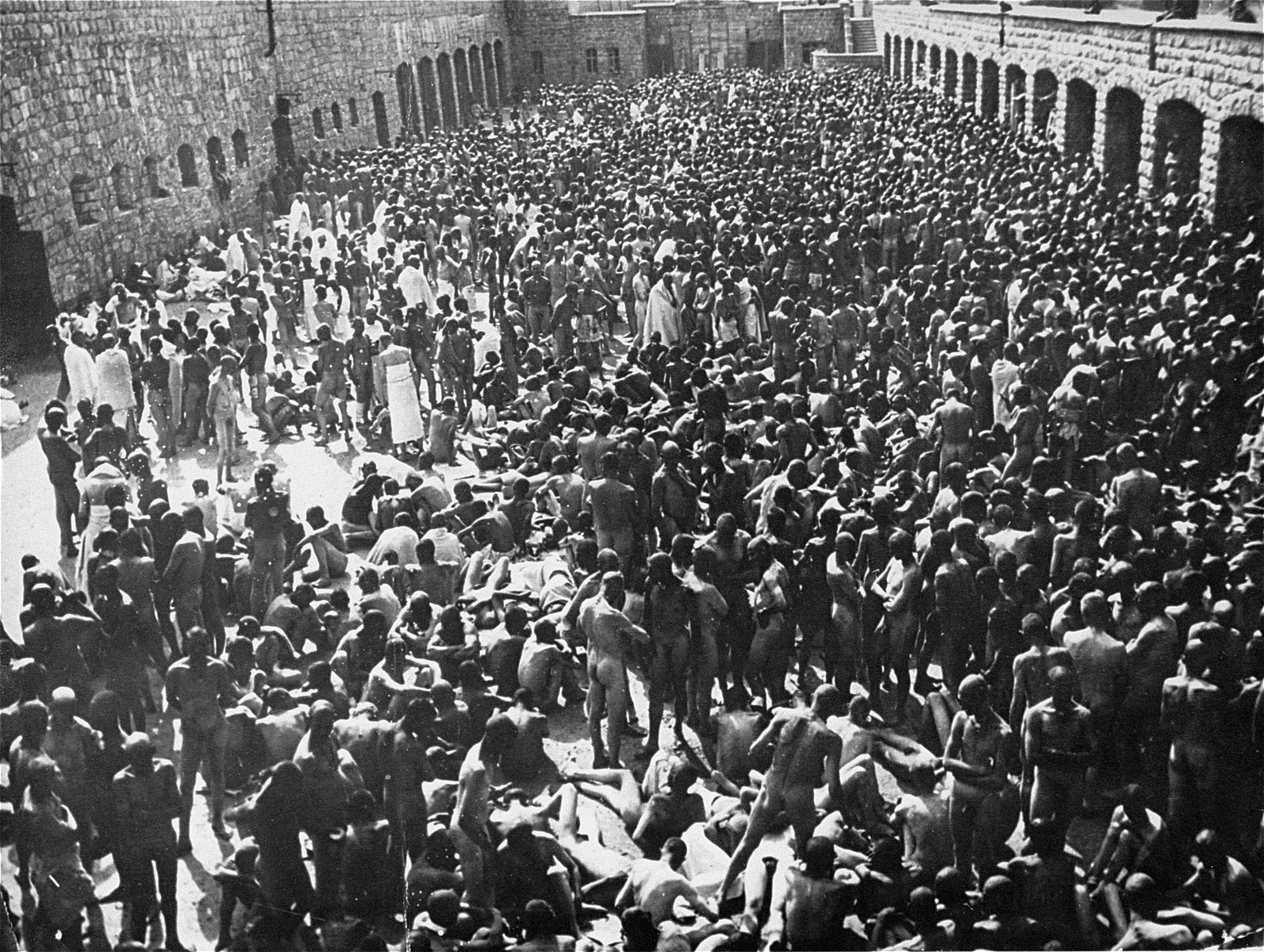 A group several hundred naked men is crowded in an enclosed courtyard, with garage doors visible on three sides. New prisoners awaiting disinfection in the garage yard of Mauthausen concentration camp Speer maintained at the Nuremberg trials and in his memoirs that he had no direct knowledge of the Holocaust. He admitted only to being uncomfortable around Jews in the published version of the Spandau Diaries.[51] In his final statement at Nuremberg, Speer gave the impression of apologizing, although he did not directly admit any personal guilt and the only victim he mentioned was the German people.[174] Historian Martin Kitchen states that Speer was actually "fully aware of what had happened to the Jews" and was "intimately involved in the 'Final Solution'".[175] Brechtken said Speer only admitted to a generalized responsibility for the Holocaust to hide his direct and actual responsibility.[159] Speer was photographed with slave laborers at Mauthausen concentration camp during a visit on 31 March 1943; he also visited Gusen concentration camp. Although survivor Francisco Boix testified at the Nuremberg trials about Speer's visit,[176] Taylor writes that, had the photo been available, he would have been hanged.[177] In 2005, The Daily Telegraph reported that documents had surfaced indicating that Speer had approved the allocation of materials for the expansion of Auschwitz concentration camp after two of his assistants inspected the facility on a day when almost a thousand Jews were massacred.[178] Heinrich Breloer, discussing the construction of Auschwitz, said Speer was not just a cog in the work—he was the "terror itself".[178] Speer did not deny being present at the Posen speeches to Nazi leaders at a conference in Posen (Poznań) on 6 October 1943, but claimed to have left the auditorium before Himmler said during his speech: "The grave decision had to be taken to cause this people to vanish from the earth",[179] and later, "The Jews must be exterminated".[180] Speer is mentioned several times in the speech, and Himmler addresses him directly.[180] In 2007, The Guardian reported that a letter from Speer dated 23 December 1971, had been found in a collection of his correspondence with Hélène Jeanty, the widow of a Belgian resistance fighter. In the letter, Speer says, "There is no doubt—I was present as Himmler announced on October 6, 1943, that all Jews would be killed."[122] Armaments miracle 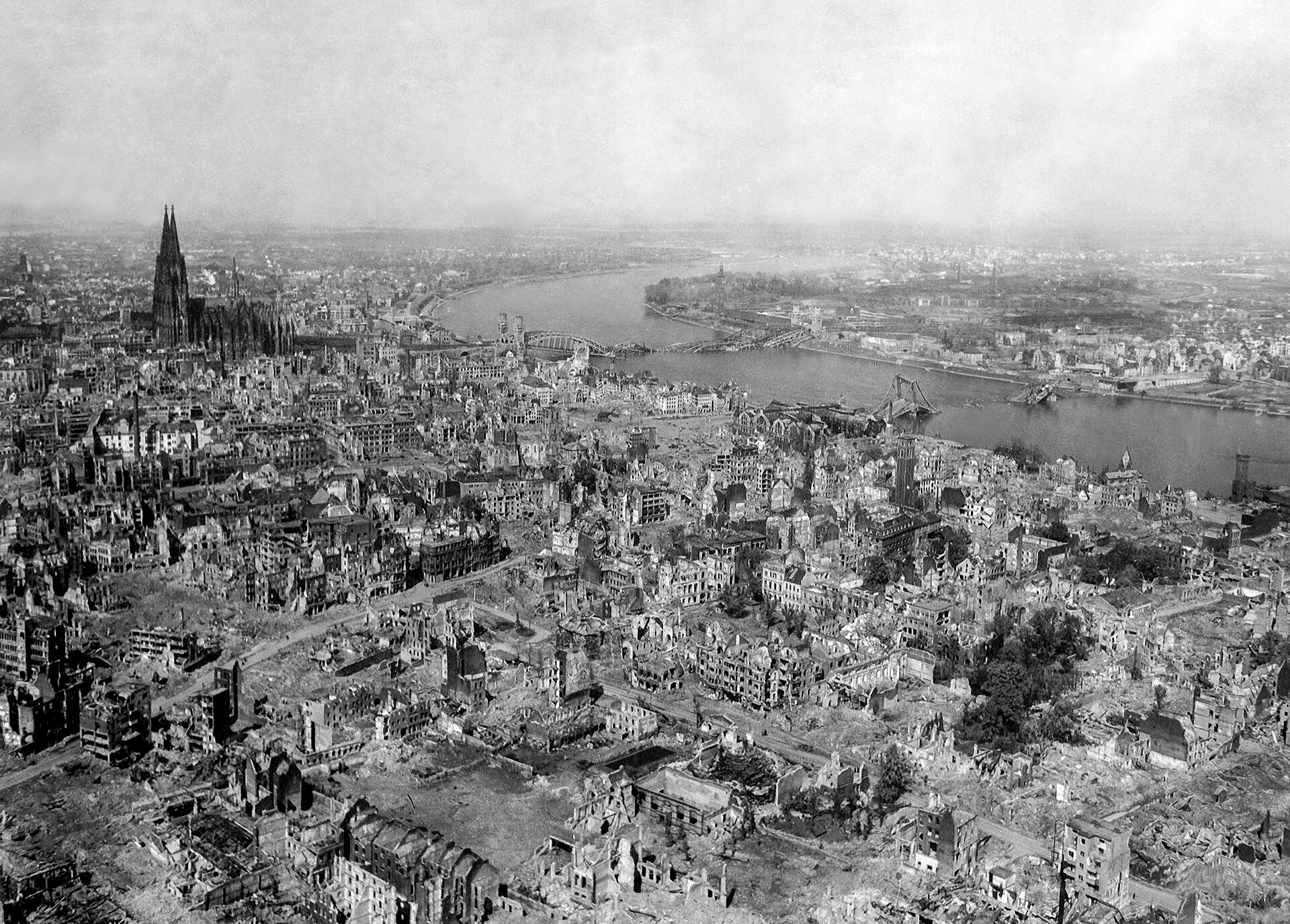 The German city of Cologne in ruins at the end of the war Speer was credited with an "armaments miracle". During the winter of 1941–42, in the light of Germany's disastrous defeat in the Battle of Moscow, the German leadership including Friedrich Fromm, Georg Thomas and Fritz Todt had come to the conclusion that the war could not be won.[181] The rational position to adopt was to seek a political solution that would end the war without defeat. Speer in response used his propaganda expertise to display a new dynamism of the war economy.[181] He produced spectacular statistics, claiming a sixfold increase in munitions production, a fourfold increase in artillery production, and he sent further propaganda to the newsreels of the country. He was able to curtail the discussion that the war should be ended.[181] The armaments "miracle" was a myth; Speer had used statistical manipulation to support his claims.[182] The production of armaments did rise; however, this was due to the normal causes of reorganization before Speer came to office, the relentless mobilization of slave labor and a deliberate reduction in the quality of output to favor quantity. By July 1943 Speer's armaments propaganda became irrelevant because a catalogue of dramatic defeats on the battlefield meant the prospect of losing the war could no longer be hidden from the German public.[183] |
シュペーア神話[編集] 善良なナチス[編集] シュパンダウから釈放された後、シュペーアは自らを「善良なナチス」として描いた[157]。彼は教養があり、中流階級で、ブルジョワであり、大衆の間で は「悪いナチス」の典型である人々と対照的であった[158]。 [159]シュペーアは自分の出生時の状況さえも捏造し、雷鳴と近くのキリスト教会の鐘が鳴り響く中、真昼に生まれたと虚偽の供述をしたが、それは3時か ら5時の間であり、教会が建てられたのはその数年後であった。 [イザベル・トロマーはシュペーアの伝記の中で、フェストとシードラーはシュペーアの回想録の共著者であり、彼の神話の共同制作者であったと書いている。 [シュペーア、シードラー、フェストは傑作を作り上げ、「善良なナチス」のイメージは、それが誤りであったことを示す歴史的証拠があるにもかかわらず、何 十年もの間、定着し続けた[163]。  1944年5月、軍需工場を訪れたシュペーア。 シュペーアは、第三帝国のとんでもない犯罪を発見できなかったことを深く後悔している非政治的な技術者であるというイメージを注意深く構築していた [164]。この構築は、歴史家ヒュー・トレバー=ローパーが 英国諜報部のためにアドルフ・ヒトラーの死を調査し、『ヒトラーの最期』を執筆する際に、ほぼ額面通りに受け入れられた。トレバー=ローパーは、シュペー アを「技術者の哲学を育んだ技術者」、自分の建設プロジェクトや閣僚としての職務にしか関心がなく、少なくともヒトラーのネロ勅令までは政治は関係ないと 考えていた人物であり、シュペーア自身の証言によれば、この勅令に対抗するために孜々として働いたと述べている。トレヴァー=ローパーは、シュペーアを、 基本的な本能が平和的で建設的であった行政の天才と呼んでいるが、しかし、ヒトラーとナチズムの不道徳性を認識しなかったシュペーアを非難し、彼を「ナチ ス・ドイツの真の犯罪者」と呼んでいる[165]。 彼の鋭い知性は、ナチスの政治と政策の本質を診断し、その異変を観察し、周囲の人物を見て軽蔑し、彼らの非道な命令を聞き、彼らの幻想的な野望を理解し た。しかし、彼は何もしなかった。政治は関係ないと考え、脇目もふらず、道路や橋や工場を建設した。その結果、シュペーアはその結果を受け入れ、行動し た。ドイツは滅亡していたのである[166]。 シュペーアの死後、マティアス・シュミットは、シュペーアがベルリンの自宅からユダヤ人を立ち退かせるよう命じたことを証明する本を出版した[167]。 1999年までに、歴史家たちはシュペーアが大嘘をついていたことを十分に証明していた[168]。 それでも、2004年にハインリッヒ・ブレロアが伝記映画『シュペーアとエル』をテレビ放映するまで、シュペーアに対する国民の認識は大きく変わることは なかった。アダム・トゥーゼは著書『破壊の報酬』の中で、シュペーアは巧みかつ冷酷に政権を操っており、盲目的に命令を遂行する技術者であったという考え は「馬鹿げている」と述べている[169]。 [169]トロンマーは、シュペアは非政治的な技術者ではなく、ナチス政権で最も強力で不謹慎な指導者の一人であったと述べた[162]。キッチンは、彼 はニュルンベルク裁判と戦後ドイツを欺いたと述べた[168]。ブレヒトケンは、ホロコーストへの彼の広範な関与が裁判の時点で知られていたならば、彼は 死刑を宣告されていただろうと述べた[26]。 善良なナチスのイメージは数多くのシュペーア神話によって支えられていた[159]。非政治的な技術者であったという神話に加えて、彼はホロコーストやユ ダヤ人迫害について完全な知識を持っていなかったと主張した。もう一つの神話は、シュペーアが軍需大臣に任命された後、ドイツの戦争マシーンに革命を起こ したというものである。彼は武器の出荷を劇的に増加させたとされ、ドイツを戦争に参加させ続けたと広く報じられた[170]。もう一つの神話の中心は、毒 ガスによるヒトラー暗殺計画の捏造であった。この神話のアイデアは、車の排気ガスが換気システムを通って入ってきたときのパニックを思い出して、彼に思い ついた。ブレヒトケンは、彼の最も大胆な嘘は、1952年にフランスのジャーナリストとのインタビューの際にでっち上げられたものだと書いている [171]。そのジャーナリストは、シュペーアがヒトラーの命令を拒否し、ヒトラーが目に涙を浮かべて立ち去るというシナリオをでっち上げた。シュペーア はそのシナリオが気に入り、回顧録に書き込んだ。このジャーナリストは知らず知らずのうちに彼の神話のひとつに協力していたのである[26]。 シュペーアはまた、自らをヒトラーの指導に反対する人物として描こうとした。7月20日計画に反対していたにもかかわらず、シュペーアは回顧録の中で計画 者に同情的であったと偽っている。彼は、ヒトラーが彼を閣僚候補リストに加えたことを知った後、残りの生涯、ヒトラーは彼に対して冷淡であったと主張し た。これはシュペーアが奨励した神話の重要な要素を形成していた[172]。シュペーアはまた、早い段階で戦争の敗北を悟り、その後は民間人の生存に必要 な資源を温存するために努力したと偽っていた[101]。実際には、さらなる抵抗が不可能になるまで戦争を長引かせようとしたため、紛争末期にドイツが 被った多数の死者と甚大な破壊の一因となった[101][173]。 責任の否定[編集] 外部画像 マウトハウゼンでのシュペアの写真  マウトハウゼン強制収容所の車庫で消毒を待つ新しい囚人たち シュペーアはニュルンベルク裁判でも回顧録でも、ホロコーストについて直接の知識はなかったと主張している。シュペーアはニュルンベルク裁判での最終陳述 で、謝罪しているような印象を与えたが、個人的な罪を直接認めたわけではなく、彼が言及した唯一の犠牲者はドイツ国民であった[174]。 [174]歴史家マーティン・キッチンは、シュペーアは実際には「ユダヤ人に何が起こったかを完全に認識していた」し、「『最終的解決』に密接に関与して いた」と述べている[175]ブレヒトケンは、シュペーアはホロコーストについての一般化された責任を認めただけで、直接的な実際の責任を隠していたと述 べている[159] シュペーアは、1943年3月31日にマウトハウゼン強制 収容所を訪問した際に、奴隷労働者と一緒に写真に収められている。生存者のフランシスコ・ボイクスはニュルンベルク裁判でシュペーアの訪問について証言し ているが[176]、テイラーは、写真が入手可能であったなら、彼は絞首刑になっていただろうと書いている[177]。 [177]2005年、『デイリー・テレグラフ』紙は、シュペーアが、ほぼ千人のユダヤ人が虐殺された日に彼の助手の二人が施設を視察した後、アウシュ ヴィッツ強制収容所の拡張のための資材の割り当てを承認したことを示す文書が表面化したと報じた[178]。 シュペーアは、1943年10月6日にポゼン(ポズナン)で開かれたナチス指導者会議でのポゼン演説に同席したことは否定しなかったが、演説の中でヒム ラーが言う前に講堂を出たと主張した: この民族を地上から消滅させるという重大な決断を下さなければならなかった」[179]、後に「ユダヤ人は絶滅させなければならない」とヒムラーが演説中 に言う前に聴衆席を離れたと主張している[180]。 2007年、『ガーディアン』紙は、ベルギーのレジスタンス戦士の未亡人エレーヌ・ジャンティとの書簡集から、1971年12月23日付のシュペーアから の手紙が発見されたと報じた。その手紙の中でシュペアは、「1943年10月6日にヒムラーがすべてのユダヤ人を殺すと発表したとき、私はその場にいたこ とは間違いありません」と述べている[122]。 軍備の奇跡[編集]  終戦時、廃墟と化したドイツの都市ケルン シュペーアは「軍備の奇跡」を起こしたとされている。1941年から42年にかけての冬、モスクワの戦いにおけるドイツの惨敗を踏まえ、フリードリッヒ・ フロム、ゲオルク・トーマス、フリッツ・トッドをはじめとするドイツ指導部は、戦争には勝てないという結論に達していた[181]。これに対してシュペー アは、プロパガンダの専門知識を駆使して戦争経済の新たなダイナミズムを誇示した[181]。 彼は目を見張るような統計を作成し、軍需品の生産が 6 倍に、大砲の生産が 4 倍に増加したと主張し、さらにプロパガンダを国内のニュース映画に送り込んだ。彼は戦争を終わらせるべきだという議論を抑制することができた[181]。 軍備の「奇跡」は神話であった。シュペーアは自分の主張を裏付けるために統計操作を使っていたのである[182]。軍備の生産は確かに増加したが、それは シュペーアが大統領に就任する前の組織再編成、奴隷労働力の執拗な動員、量を優先するための意図的な生産の質の低下という通常の原因によるものであった。 1943年7月までにシュペーアの軍備宣伝は無意味なものとなった。戦場での劇的な敗北のカタログは、戦争に負ける見通しをもはやドイツ国民から隠すこと ができないことを意味していたからである[183]。 |
Architectural legacy Colour photograph of a cylindrical structure Schwerbelastungskörper in 2011 Little remains of Speer's personal architectural works, other than the plans and photographs. No buildings designed by Speer during the Nazi era are extant in Berlin, other than the 4 entrance pavilions and underpasses leading to the Victory Column, or Siegessäule,[184] and the Schwerbelastungskörper, a heavy load-bearing body built around 1941. The concrete cylinder, 14 metres (46 ft) high, was used to measure ground subsidence as part of feasibility studies for a massive triumphal arch and other large structures planned within Hitler's post-war renewal project for the city of Berlin as the world capital Germania. The cylinder is now a protected landmark and is open to the public.[185] The tribune of the Zeppelinfeld stadium in Nuremberg, though partly demolished, can also be seen.[186] During the war, the Speer-designed New Reich Chancellery was largely destroyed by air raids and in the Battle of Berlin. The exterior walls survived, but they were eventually dismantled by the Soviets. Unsubstantiated rumors have claimed that the remains were used for other building projects such as the Humboldt University, Mohrenstraße metro station and Soviet war memorials in Berlin.[187] |
建築遺産[編集] 2011年のシュヴェルベラストゥングスケルパー シュペーアの個人的な建築作品は、設計図と写真以外にはほとんど残っていない。ナチス時代にシュペーアが設計した建物は、戦勝記念塔 (Siegessäule)[184]につながる4つの入口パヴィリオンと地下道、そして1941年頃に建設された重量のある耐荷重ボディである Schwerbelastungskörper以外にはベルリンに現存していない。高さ14メートル(46フィート)のコンクリート製の円柱は、ヒトラー が戦後、世界の首都ゲルマニアとしてベルリン市を刷新するプロジェクトの中で計画した巨大な凱旋門やその他の大型建造物の実現可能性調査の一環として、地 盤沈下の測定に使用された。ニュルンベルクのツェッペリンフェルト競技場のトリビューンも、一部は取り壊されたものの見ることができる[186]。 戦時中、シュペーア設計の新帝国首相官邸は空襲とベルリンの戦いで大部分が破壊された。外壁は生き残ったものの、最終的にはソビエトによって解体された。 根拠のない噂では、残骸はフンボルト大学、地下鉄のモーレン通り駅、ベルリンのソ連戦没者記念碑など他の建築プロジェクトに使われたとされている [187]。 |
| Speer Goes to Hollywood Downfall, 2004 German film where he was portrayed by actor Heino Ferch Legion Speer Transportflotte Speer Transportkorps Speer Hermann Giesler |
スピアー、ハリウッドへ行く 2004年のドイツ映画『Downfall』では、俳優ハイノ・フェルヒがシュペーアを演じた。 軍団シュペーア 輸送部隊シュペーア トランスポートコルプス・シュペーア ヘルマン・ギースラー |
| https://en.wikipedia.org/wiki/Albert_Speer |
|
リンク(強制労働関係)
リンク
文献(伝記や評価関係)
文献(ペーパークリップならびに戦犯関 係)
その他の情報
Copyright Mitzub'ixi Quq Chi'j, 2018-2019
Albert Speer, Adolf Hitler, and Arno Breker in
Paris, June 23, 1940
Do not paste, but
[Re]Think our message for all undergraduate
students!!!
++
Copyleft, CC, Mitzub'ixi Quq Chi'j, 1996-2099
☆
 ☆
☆